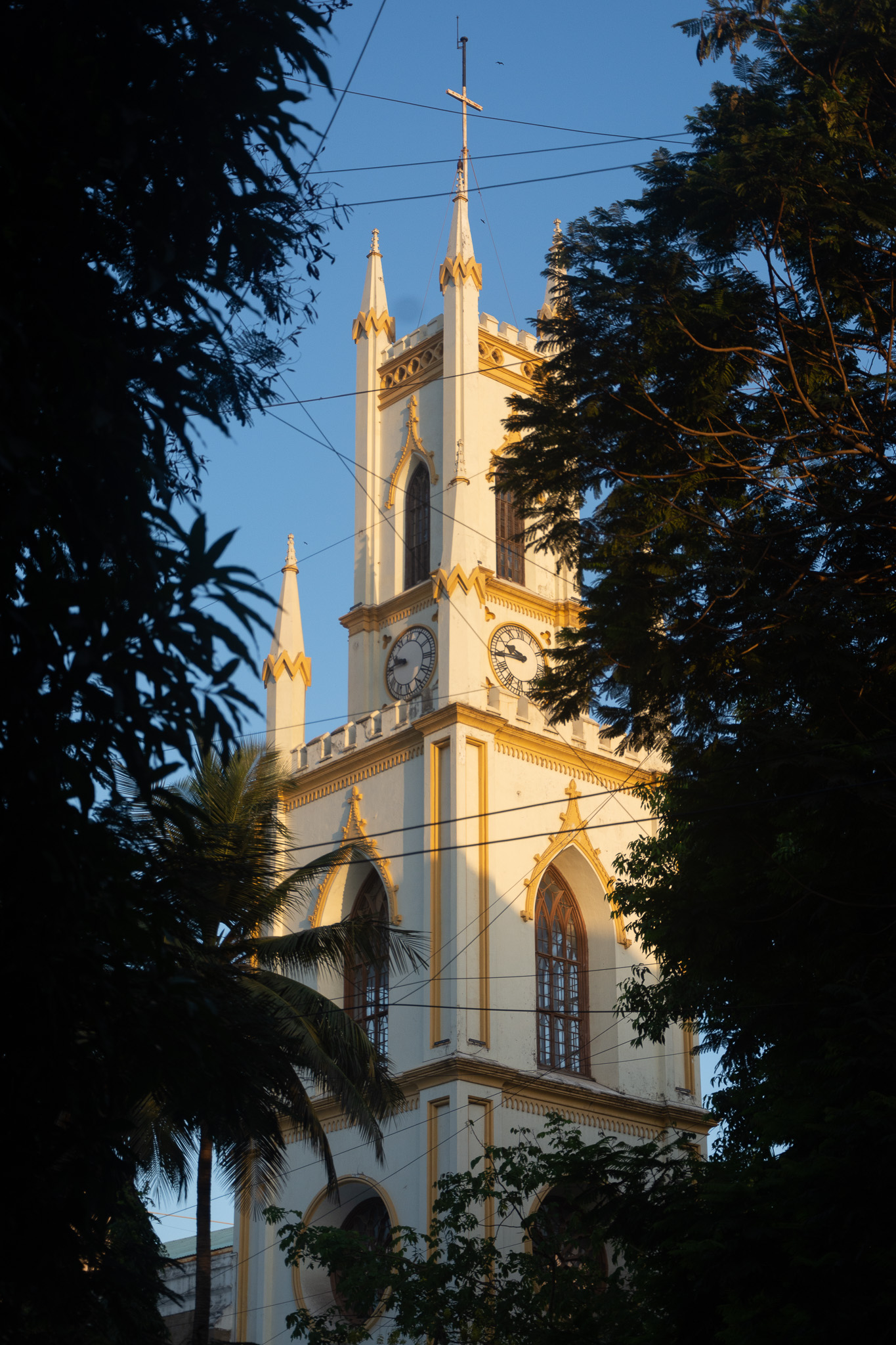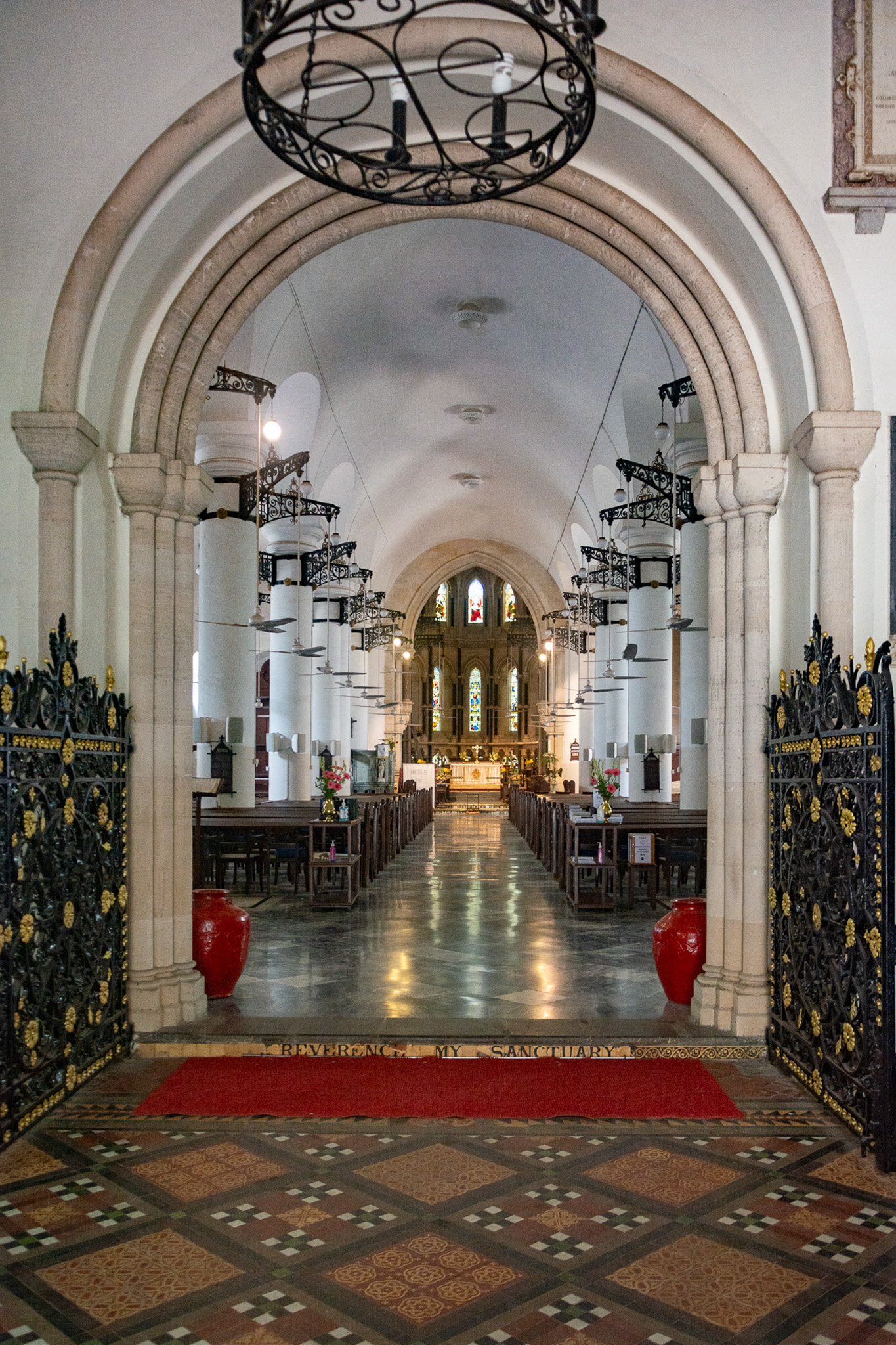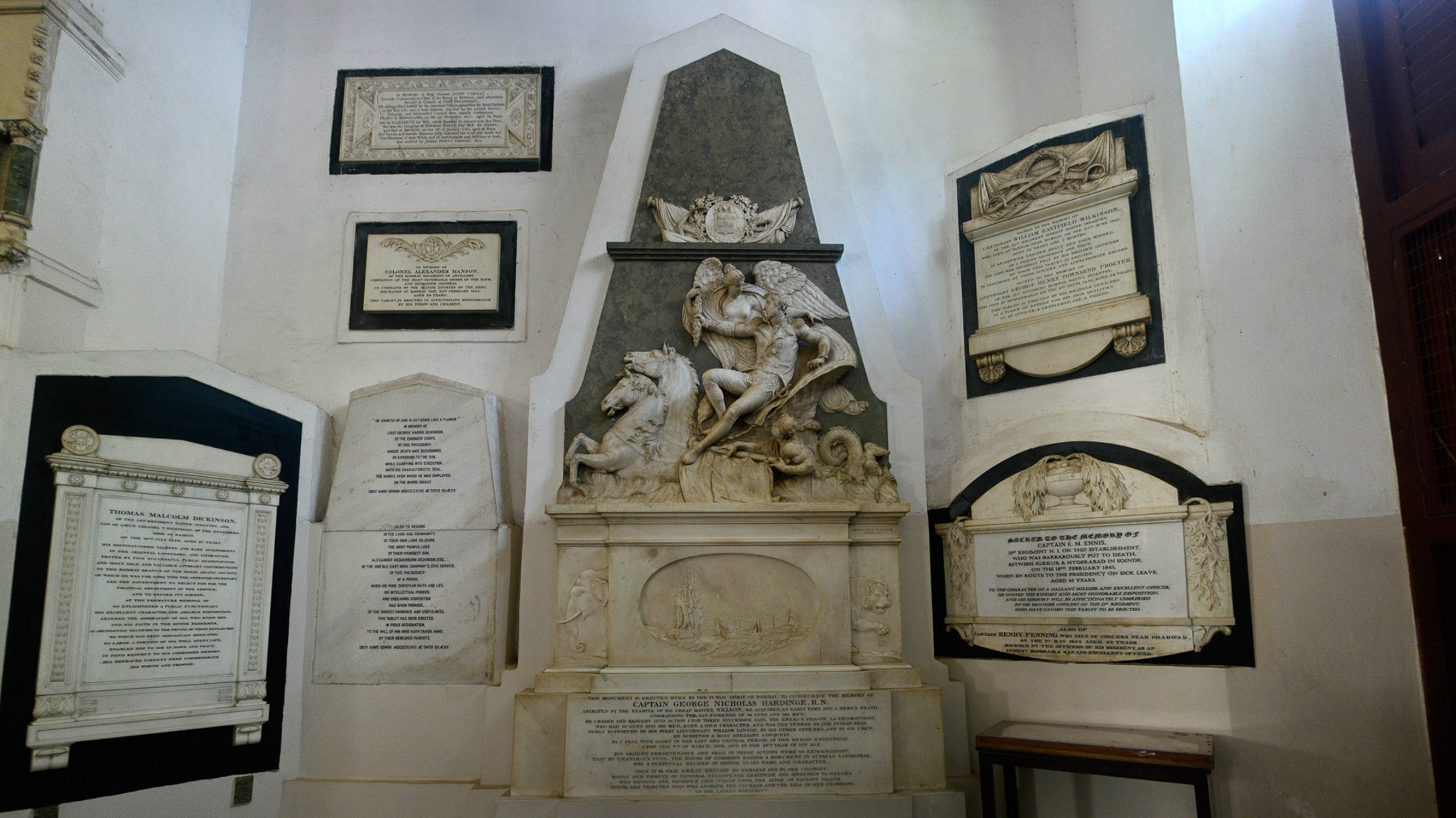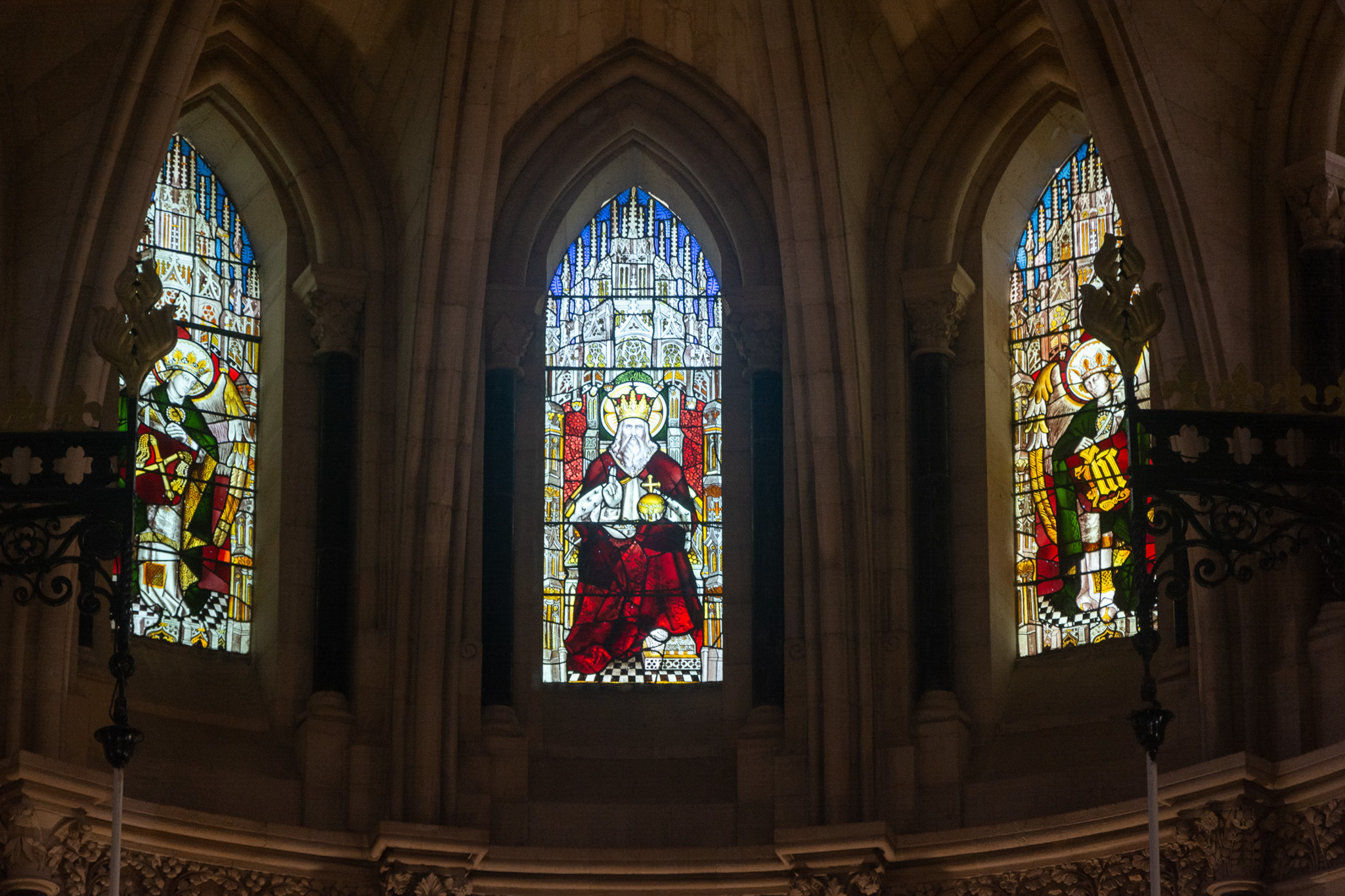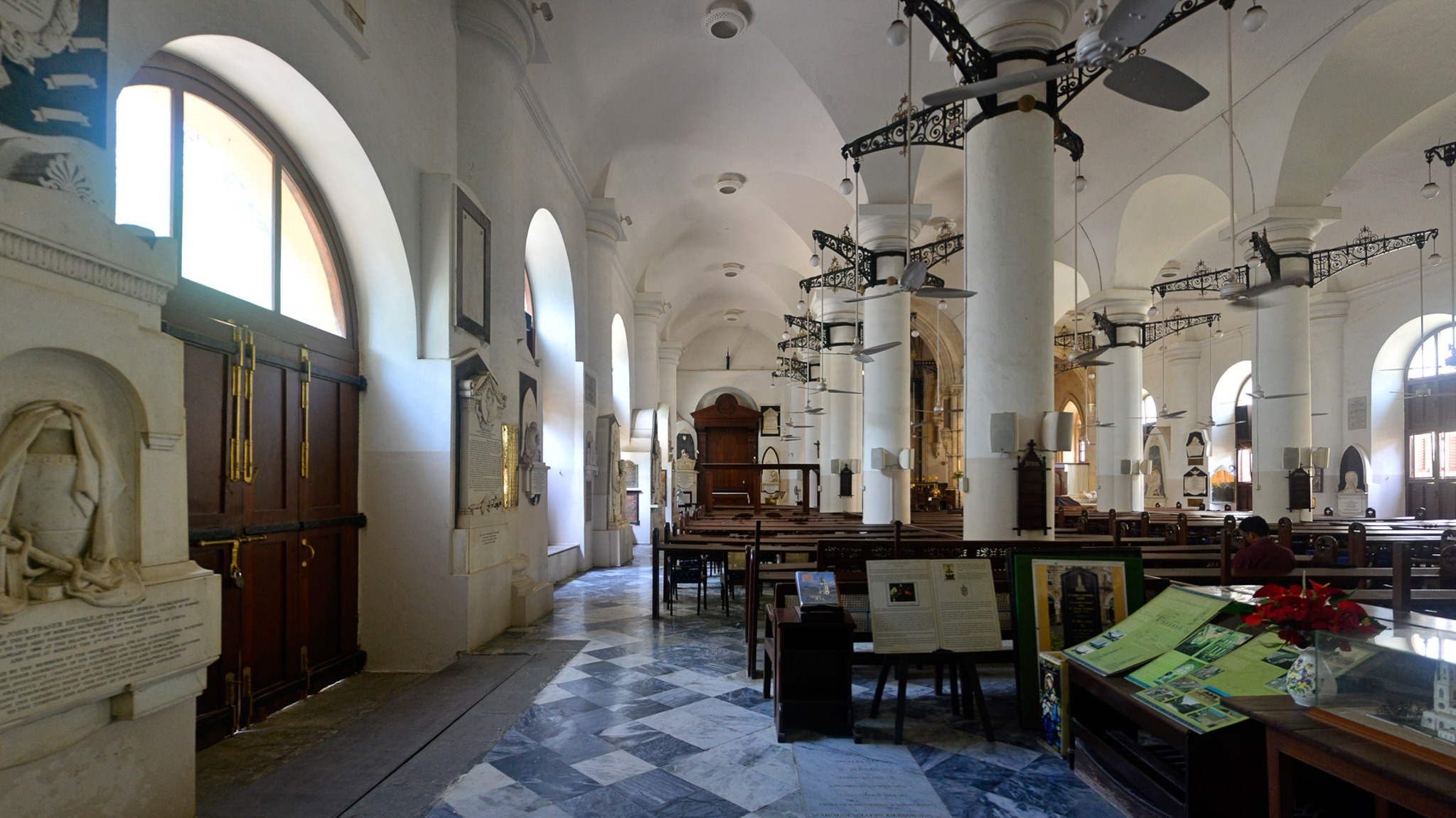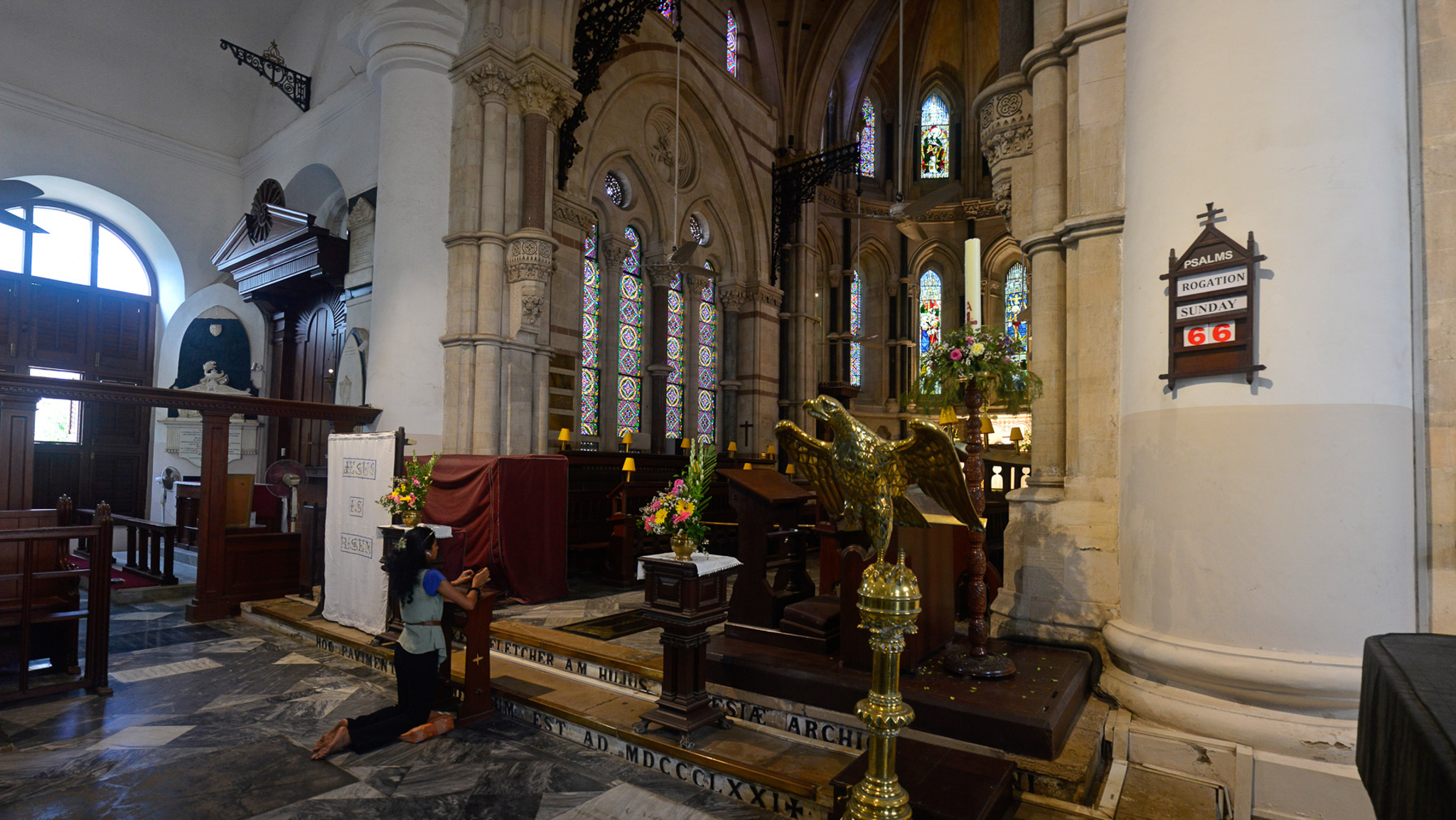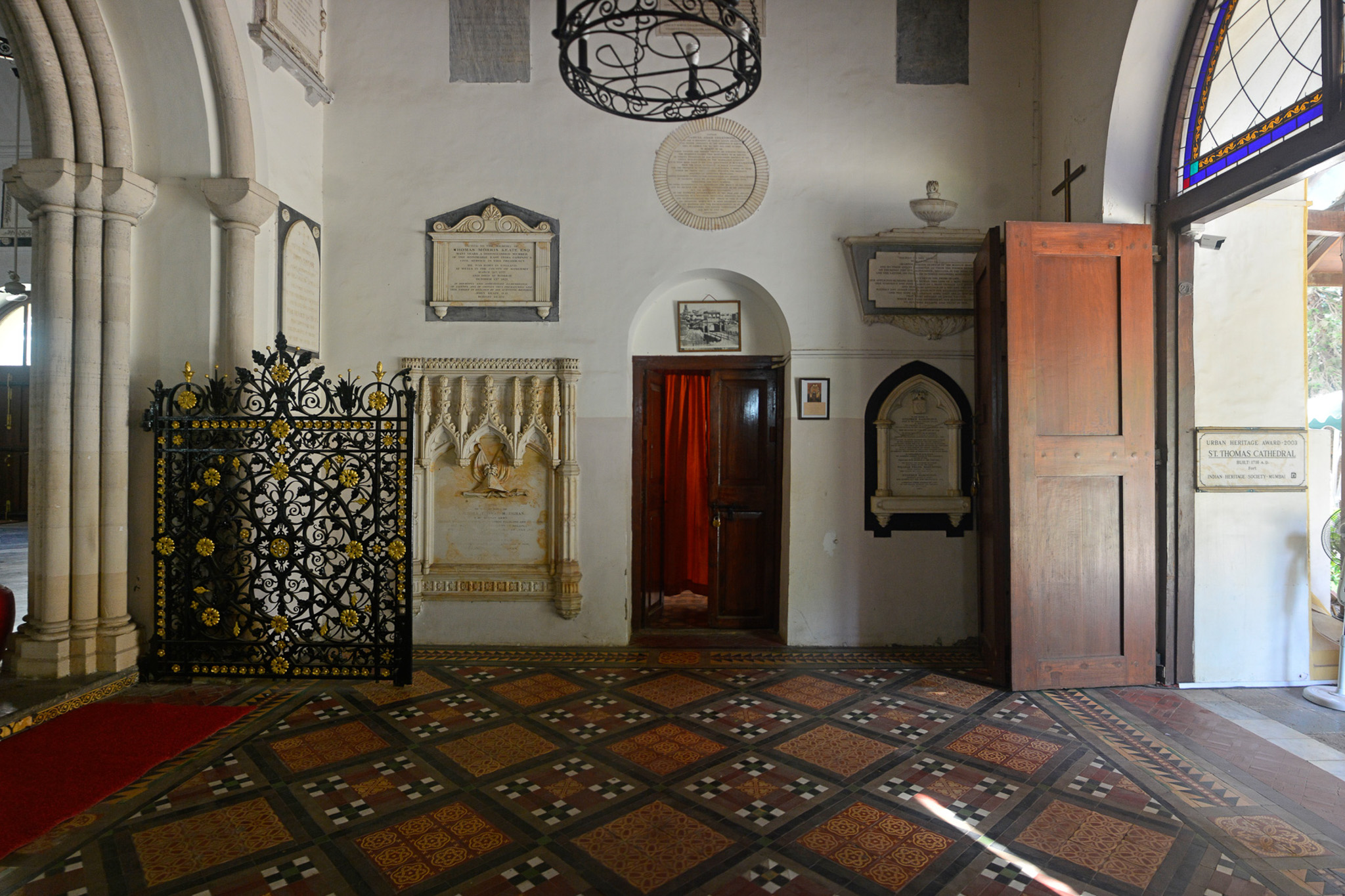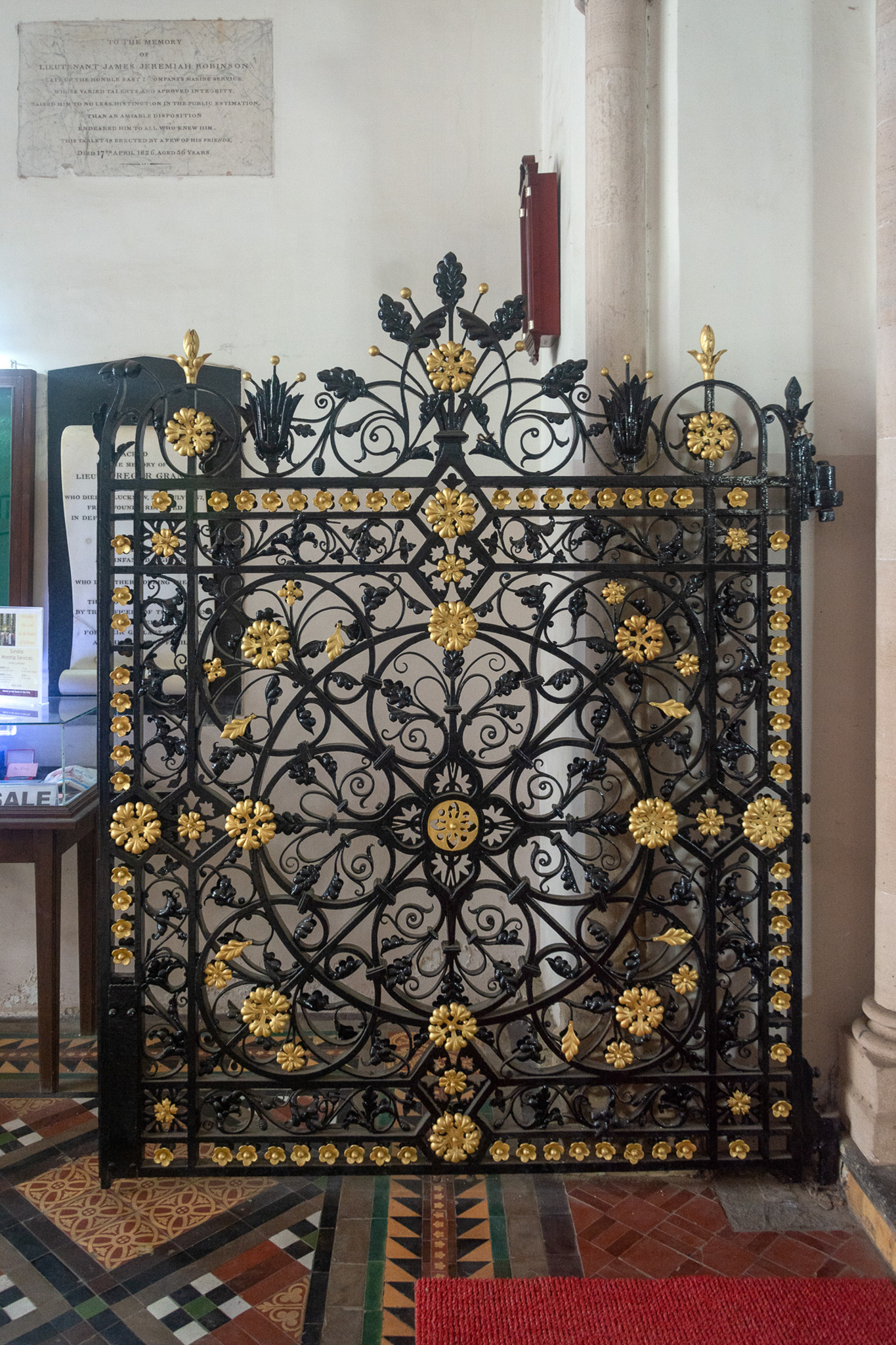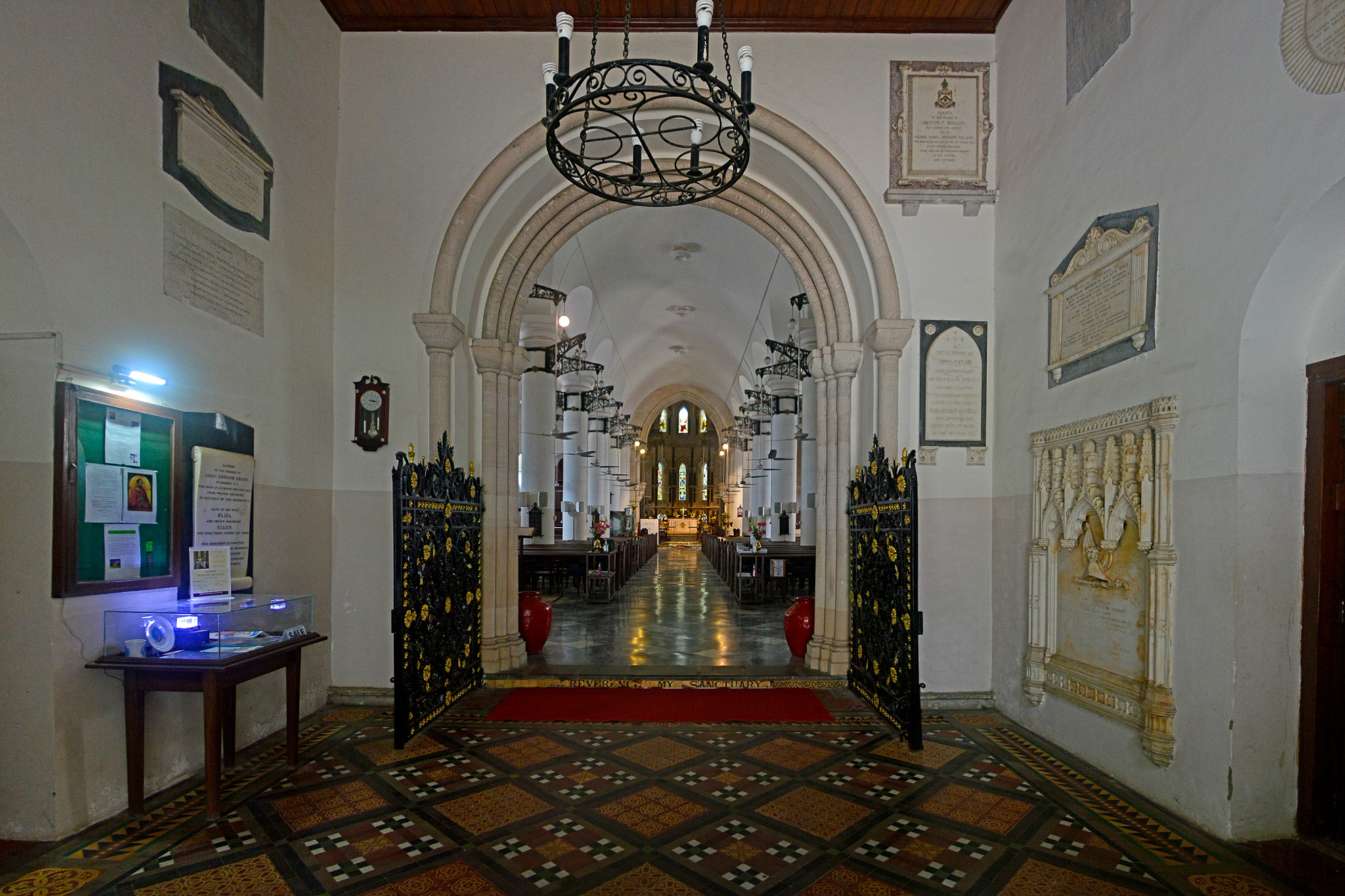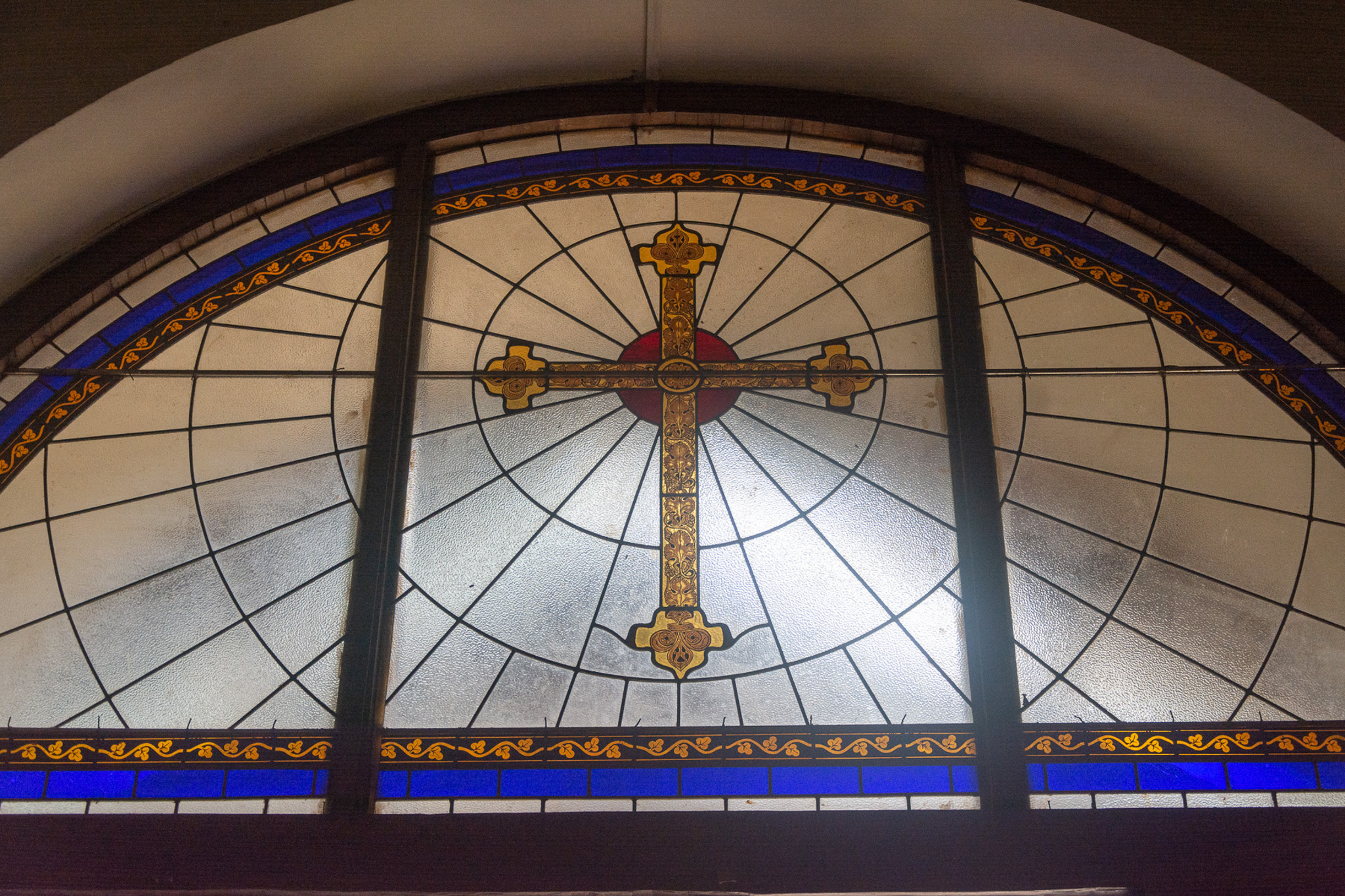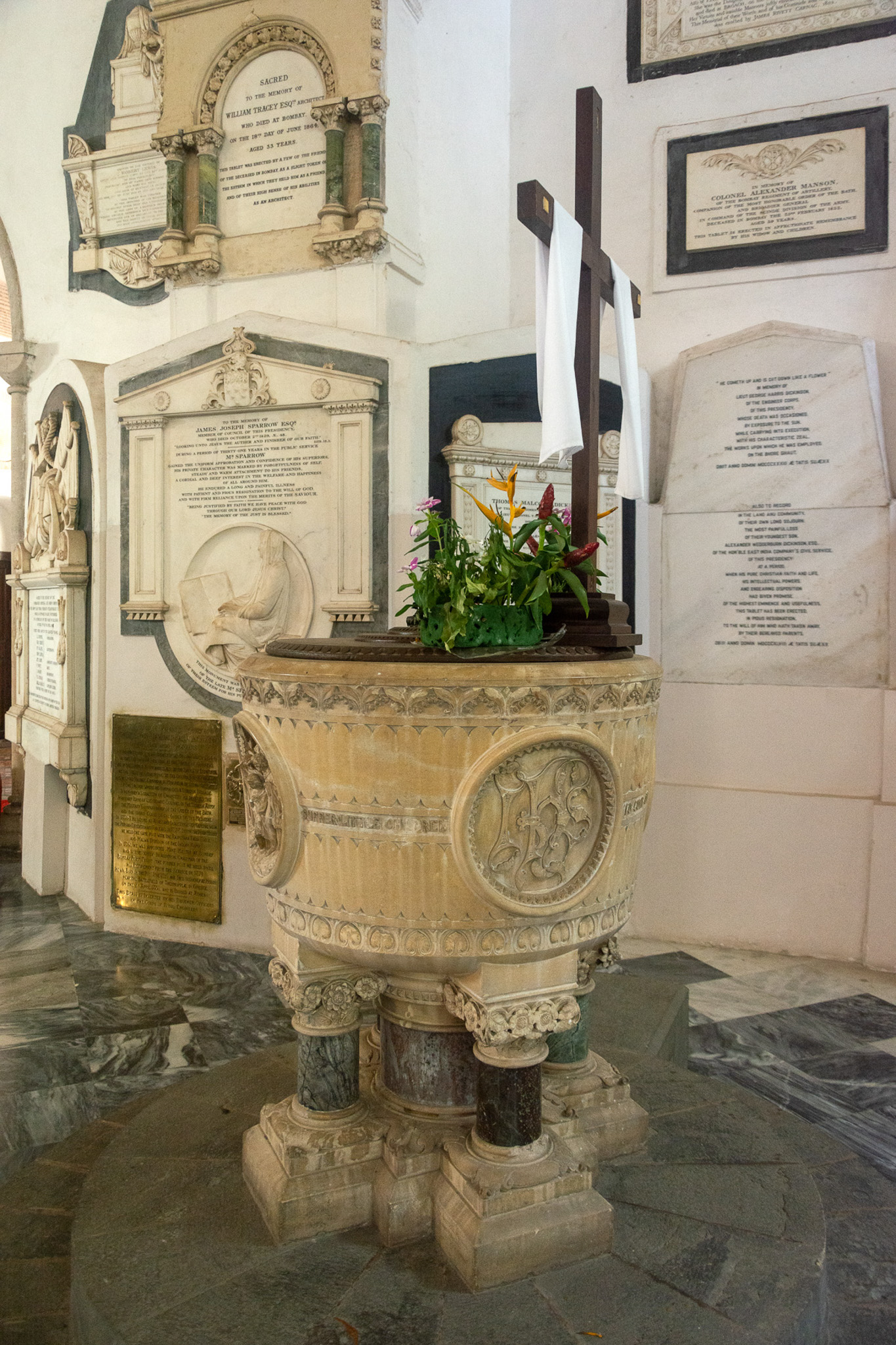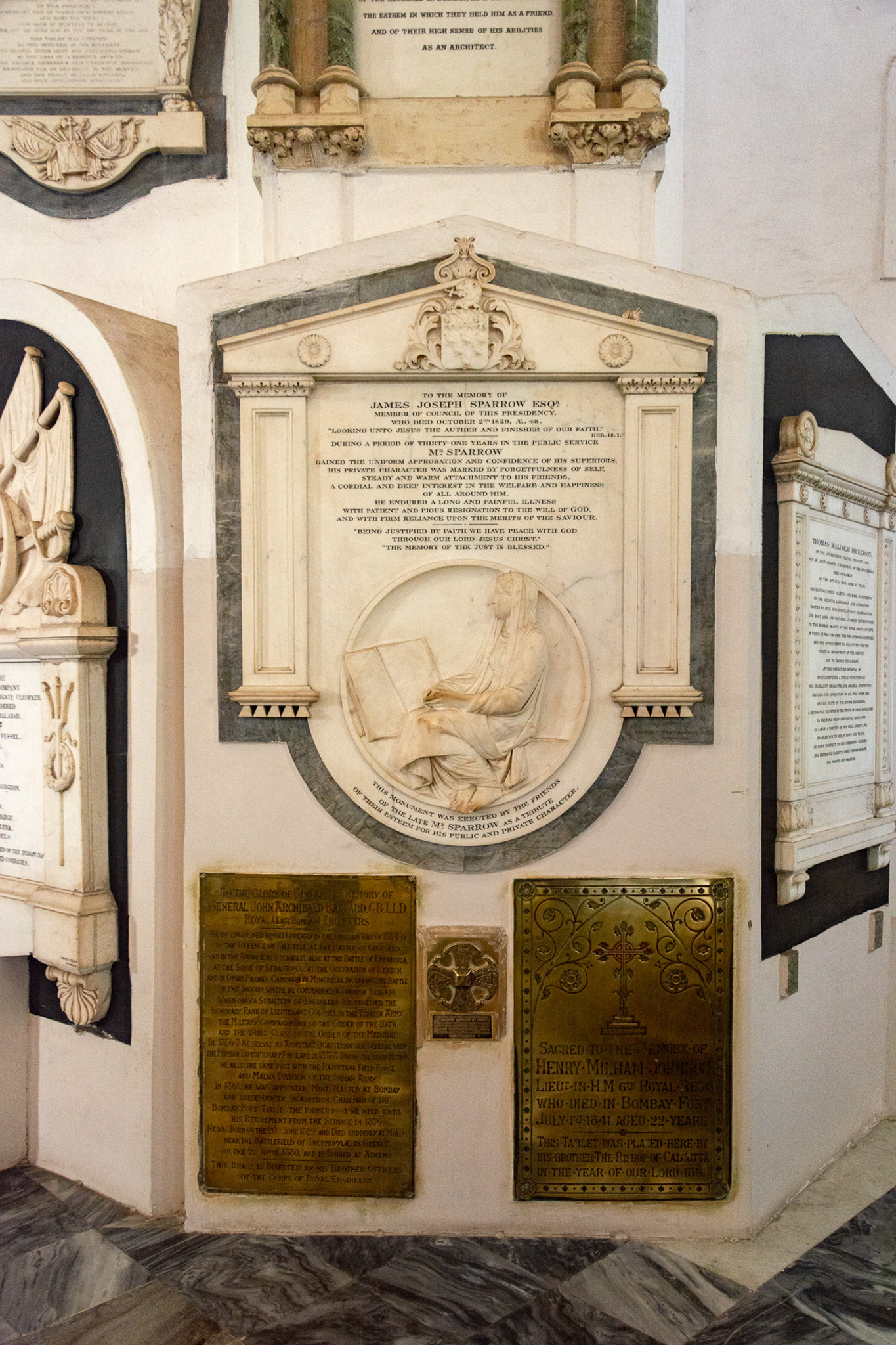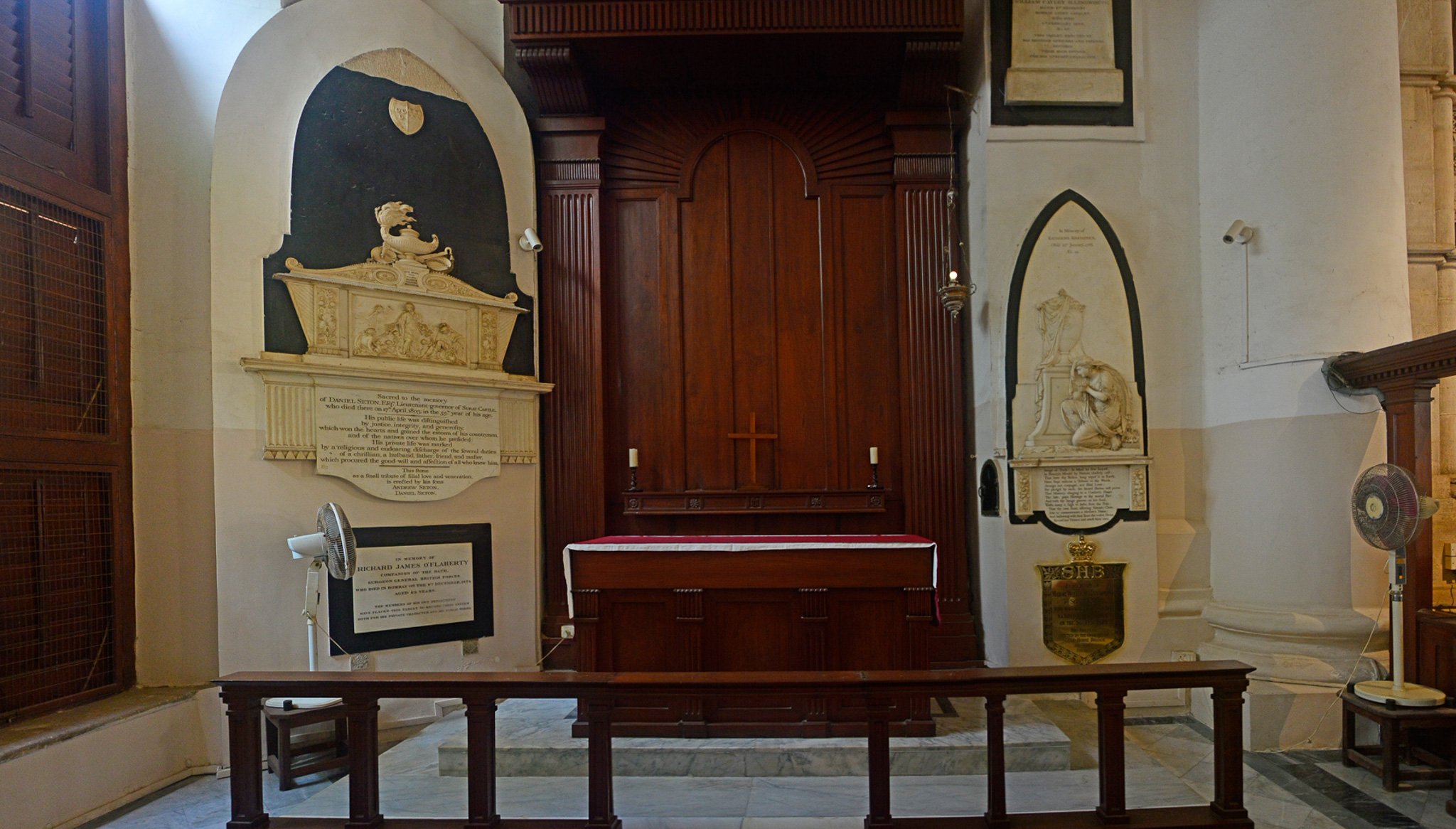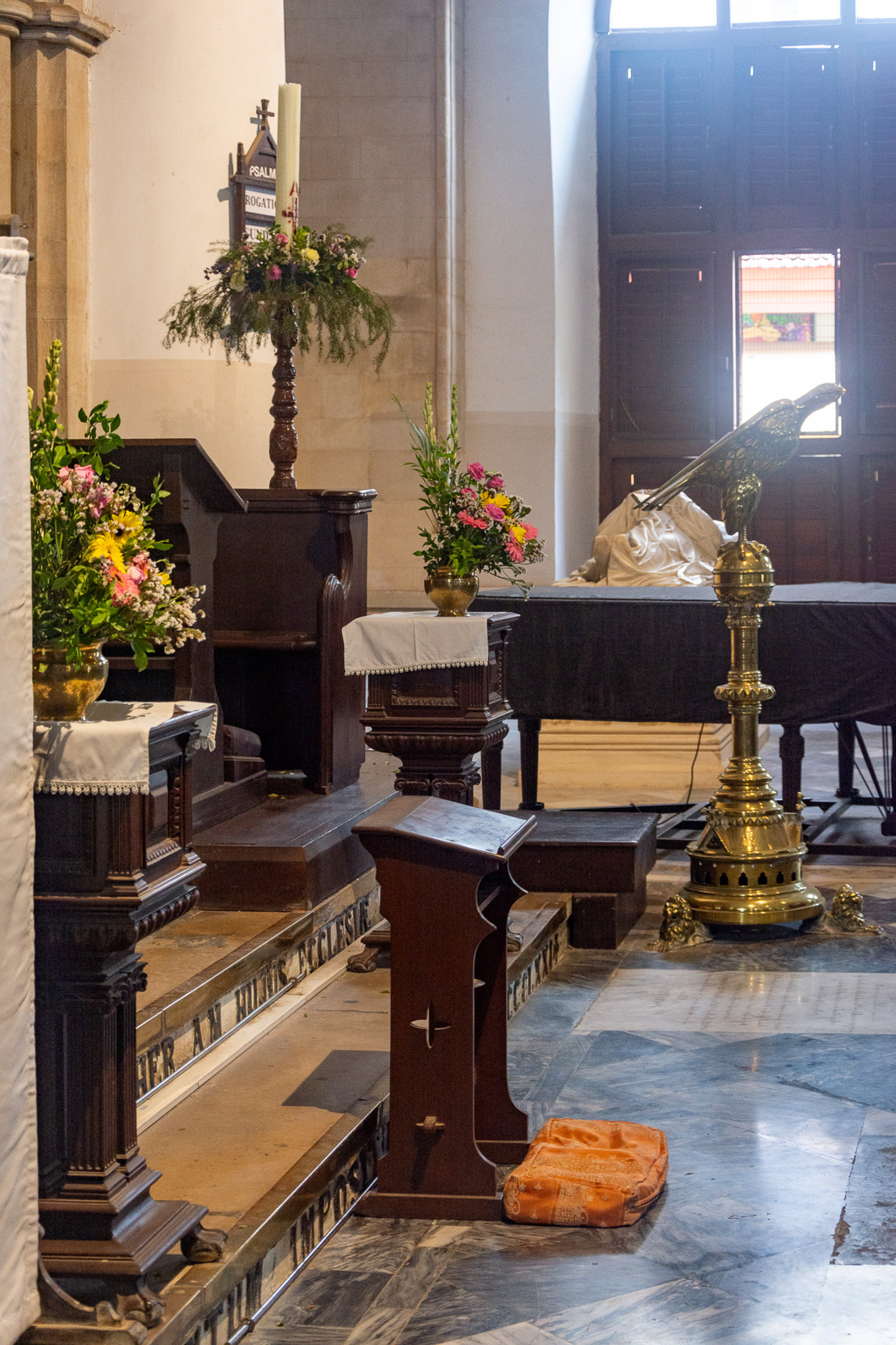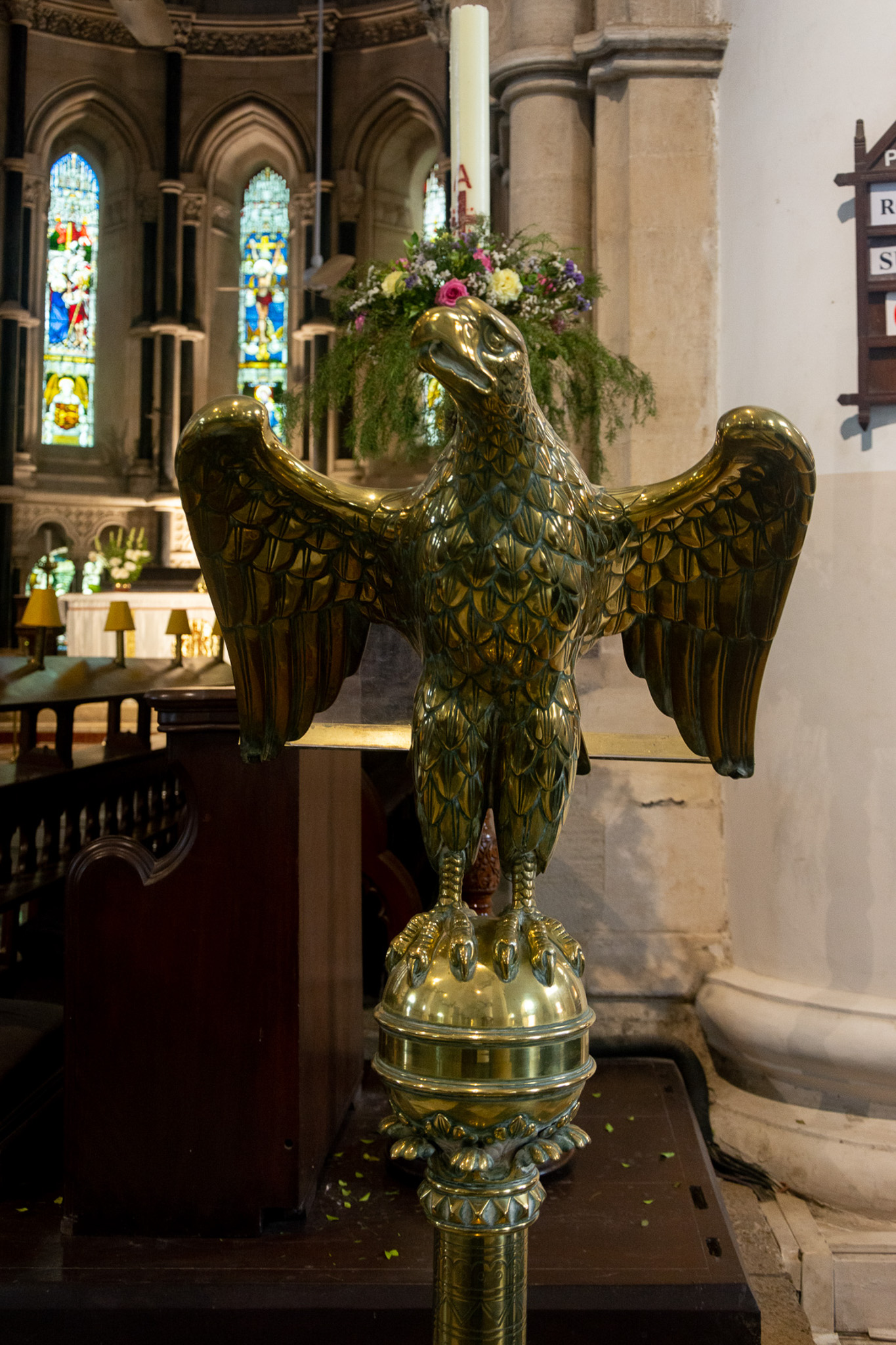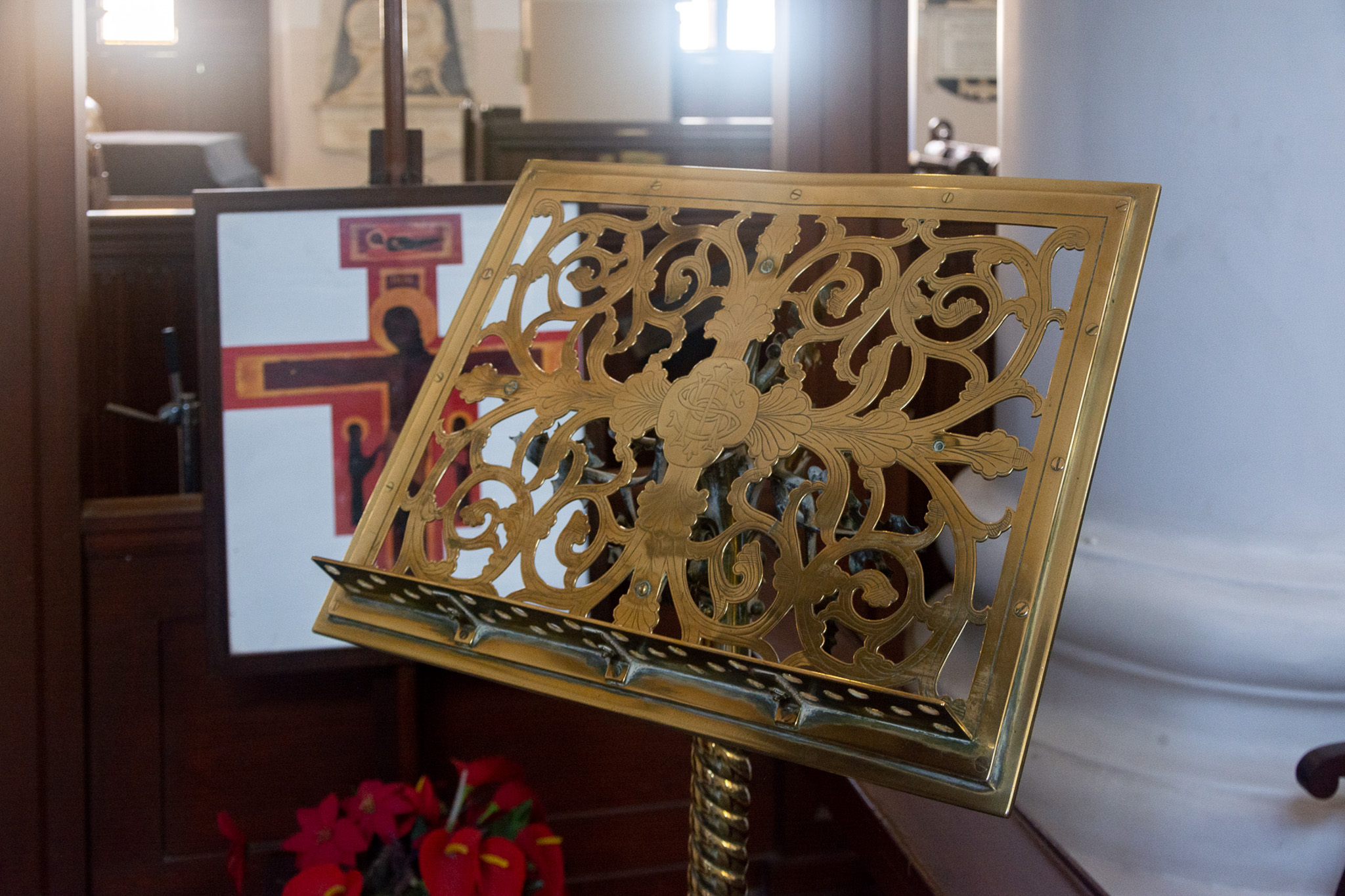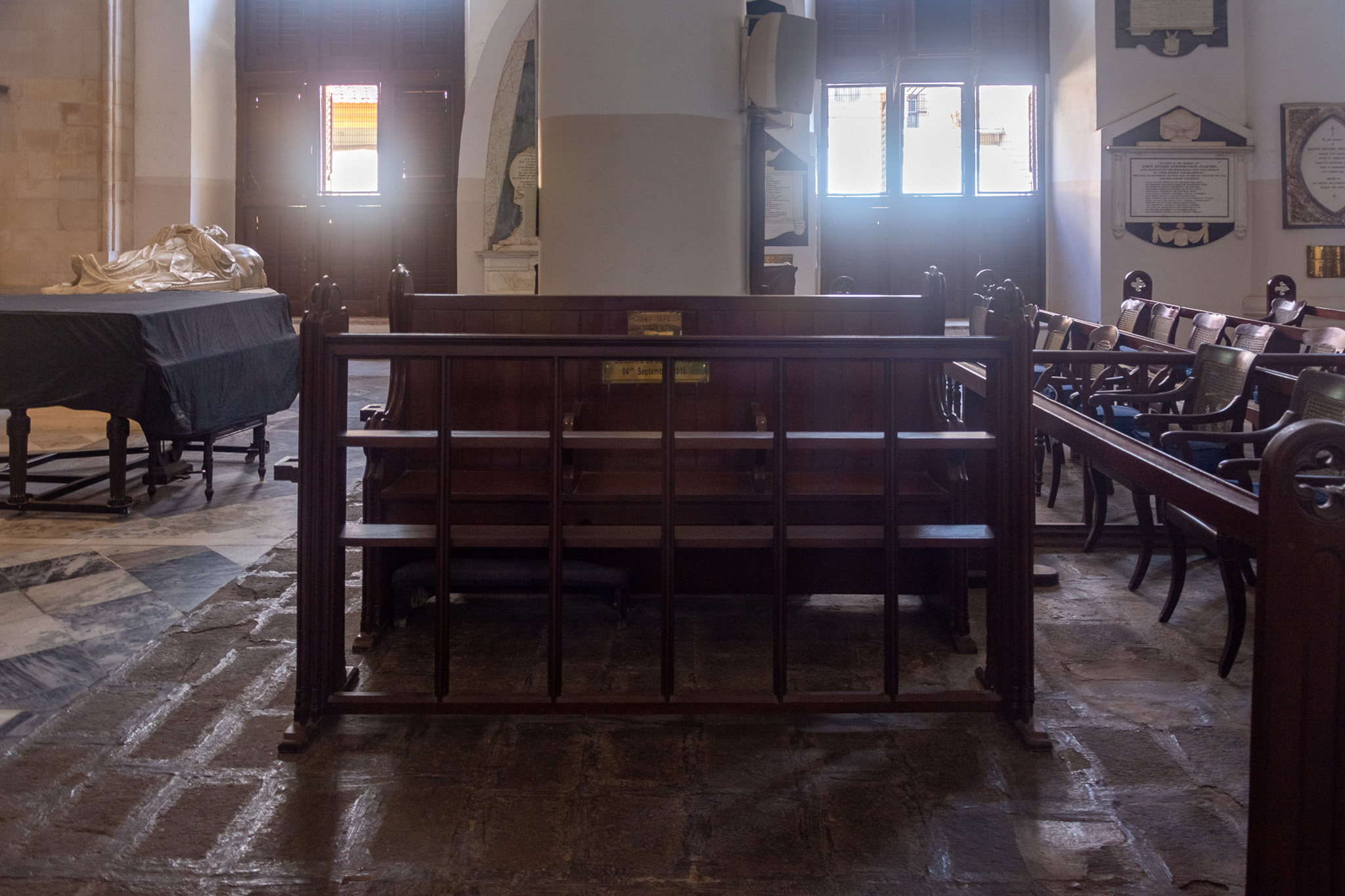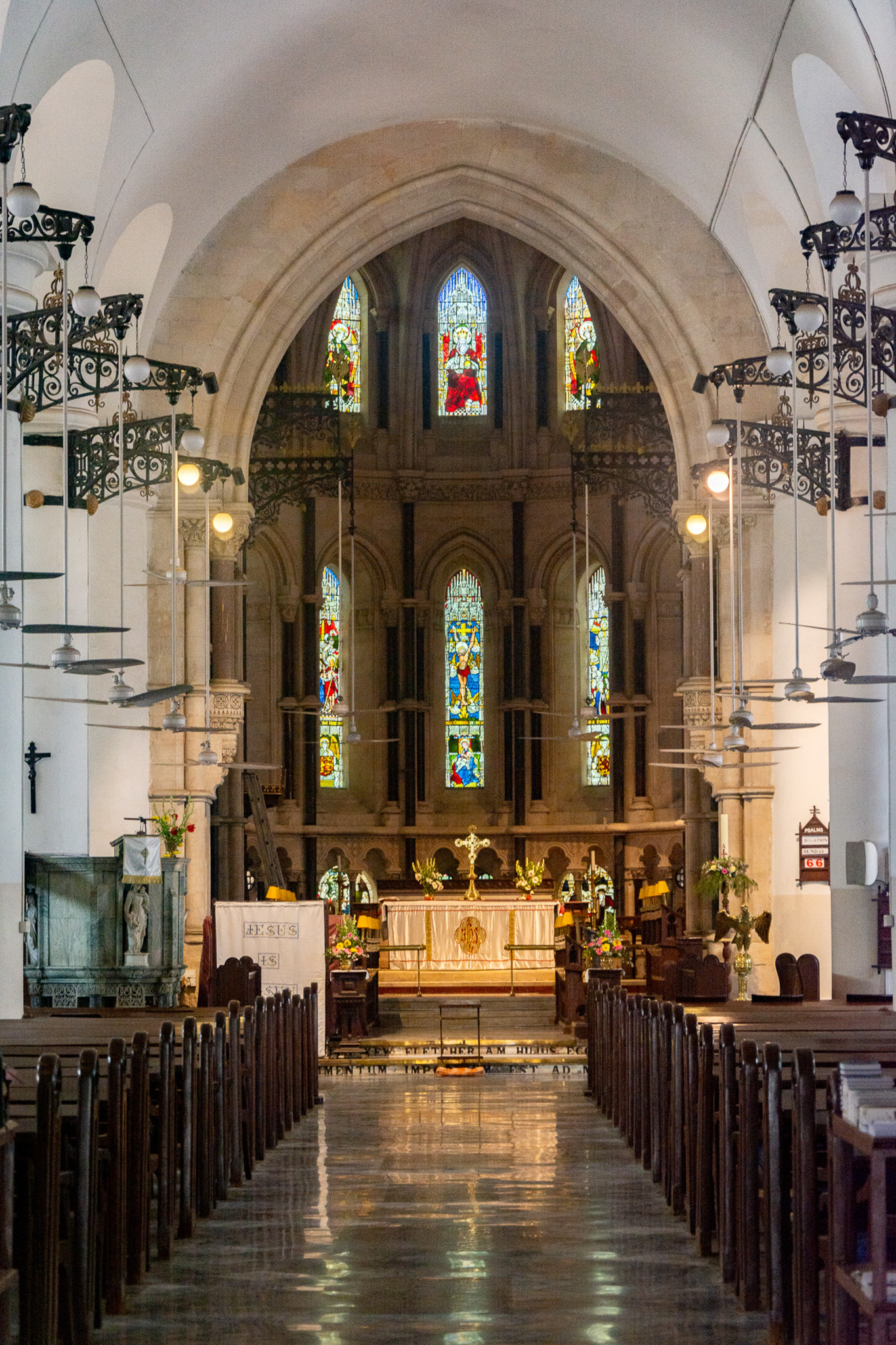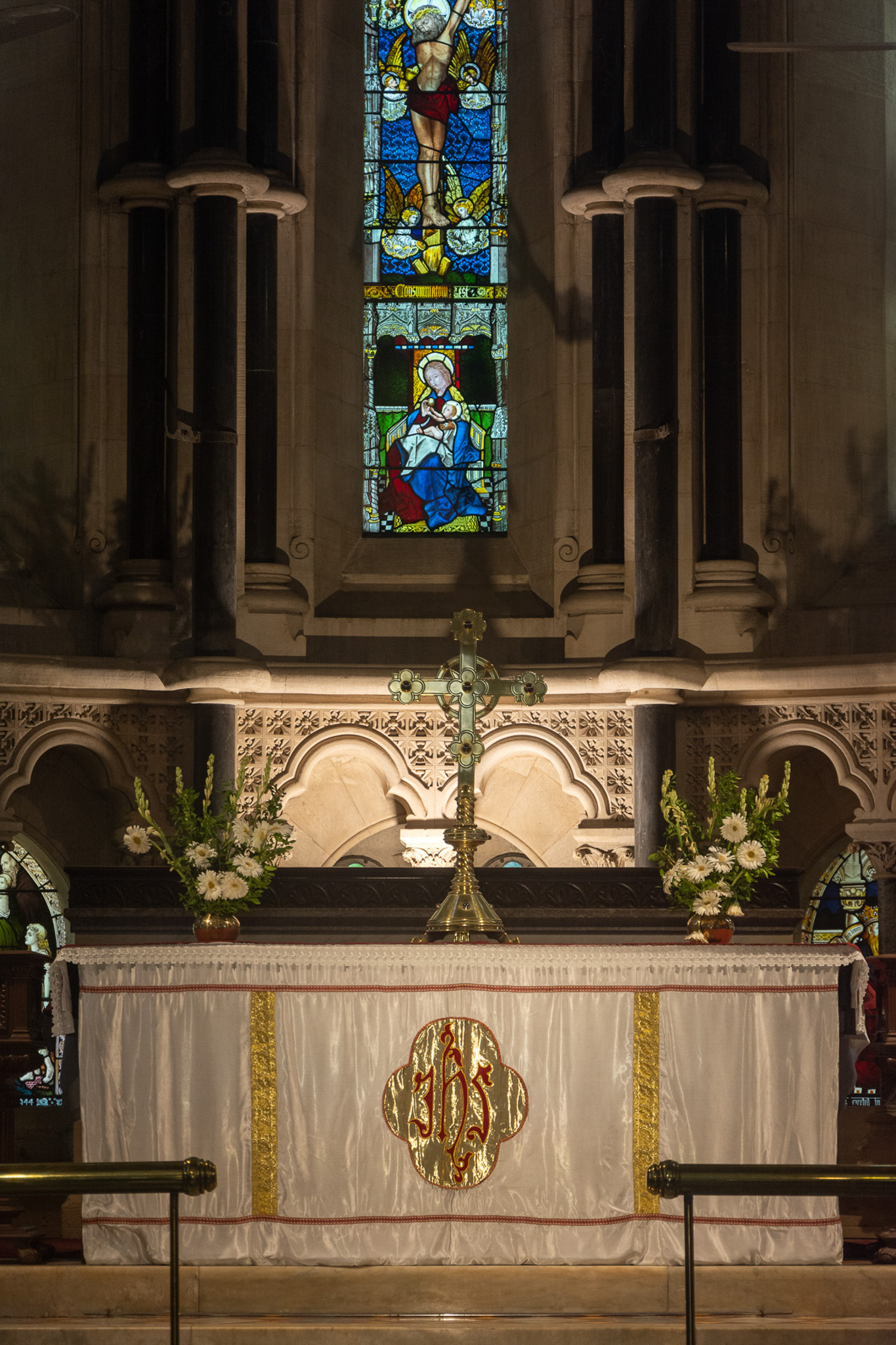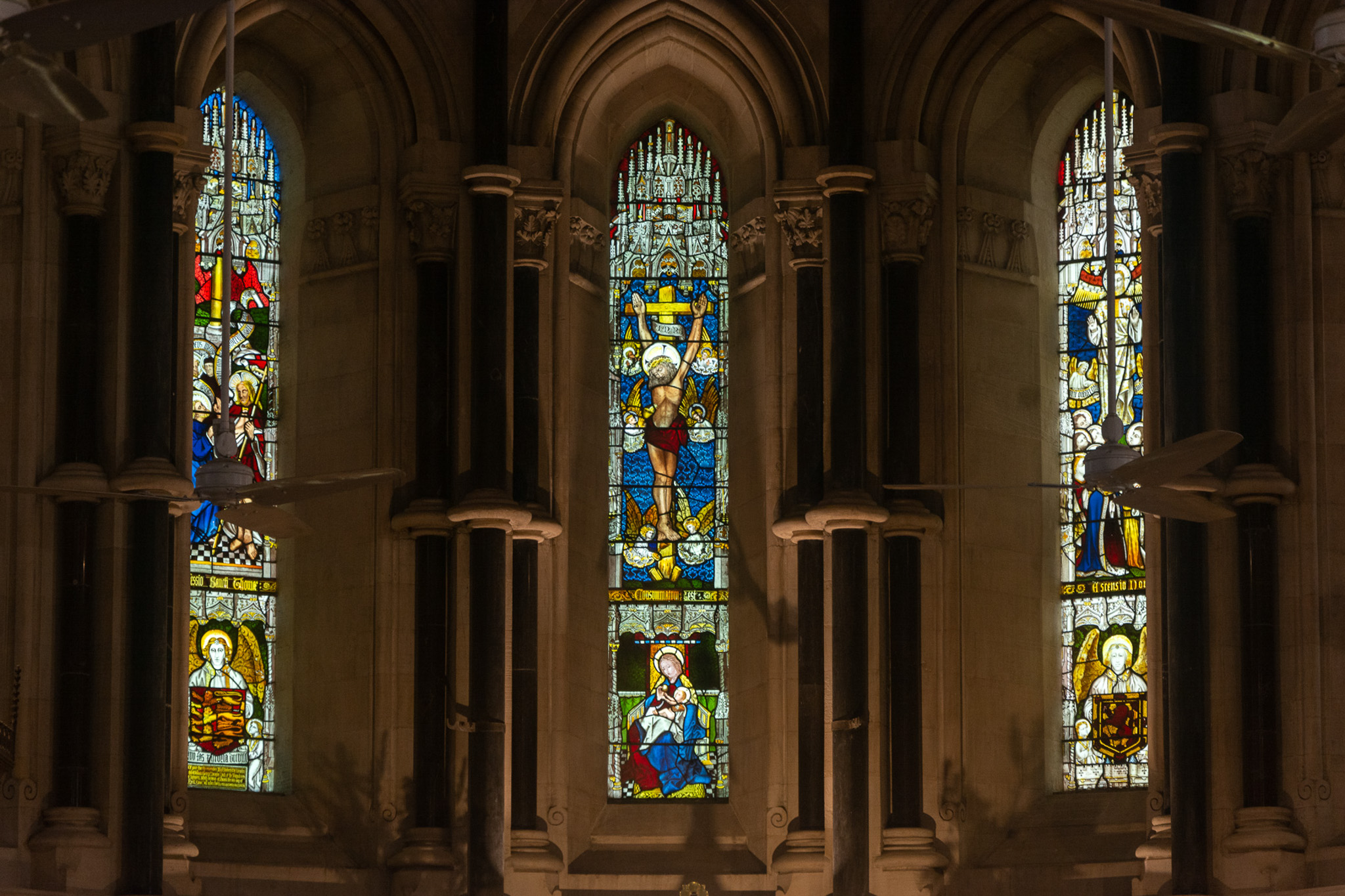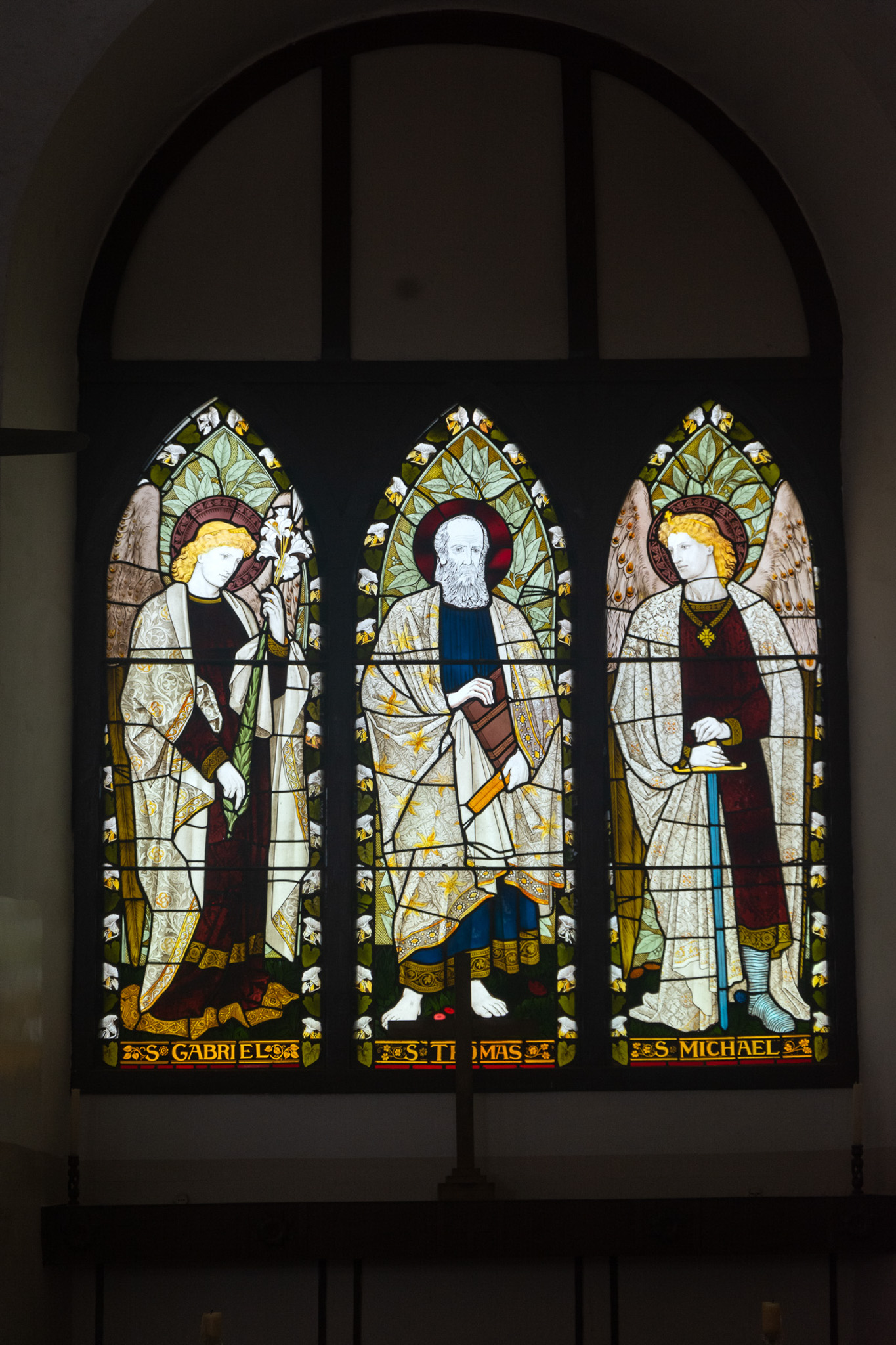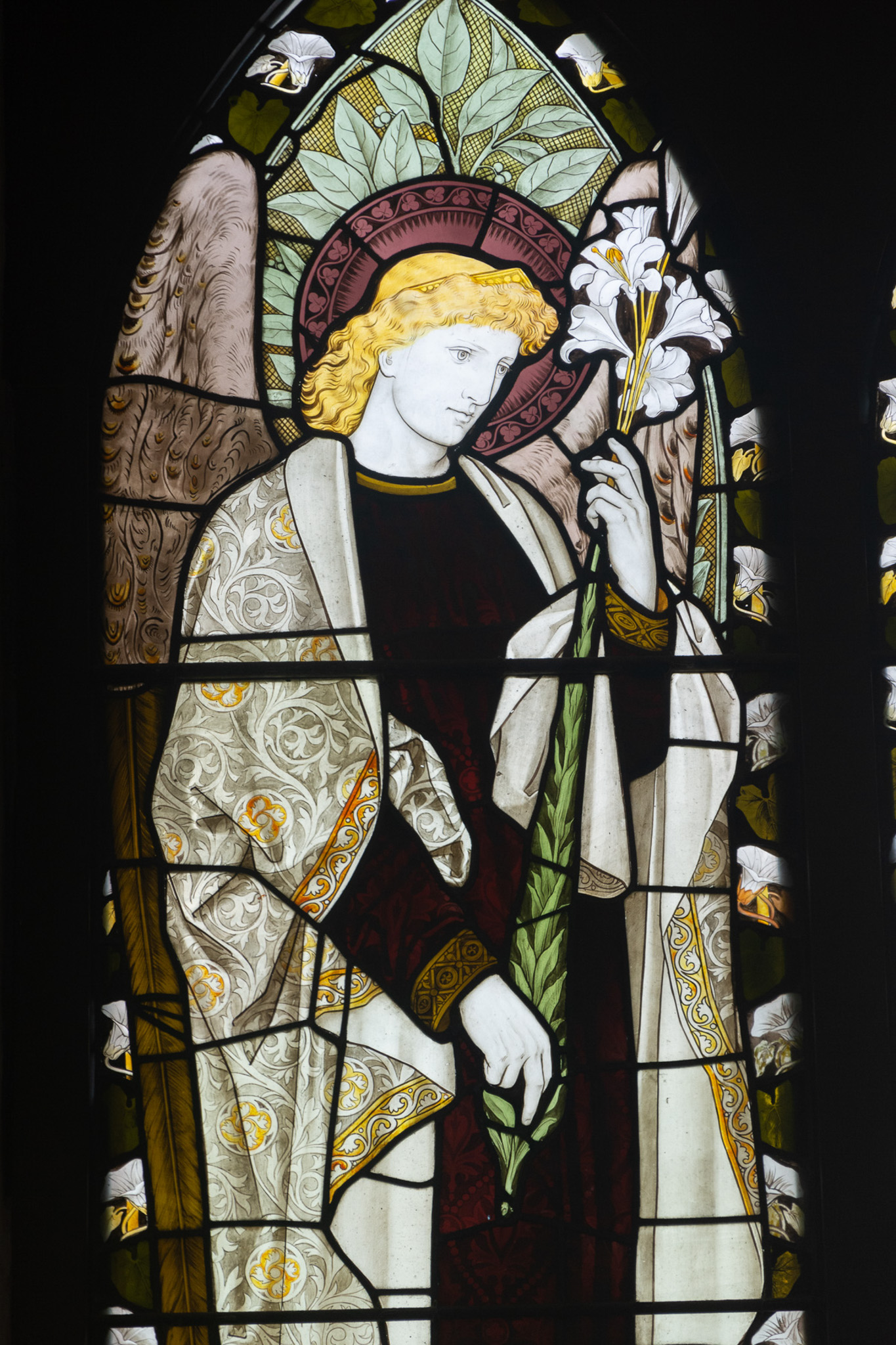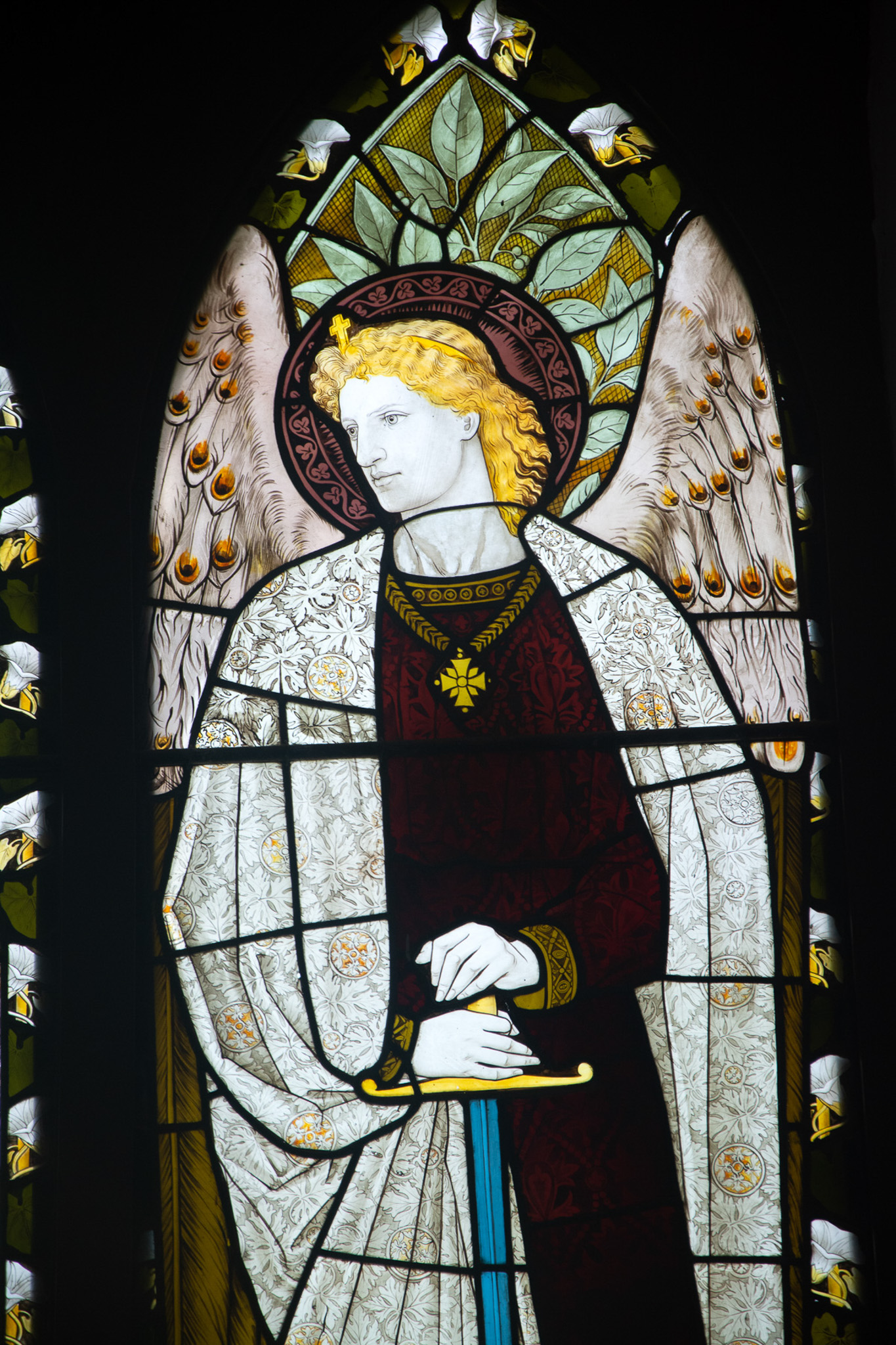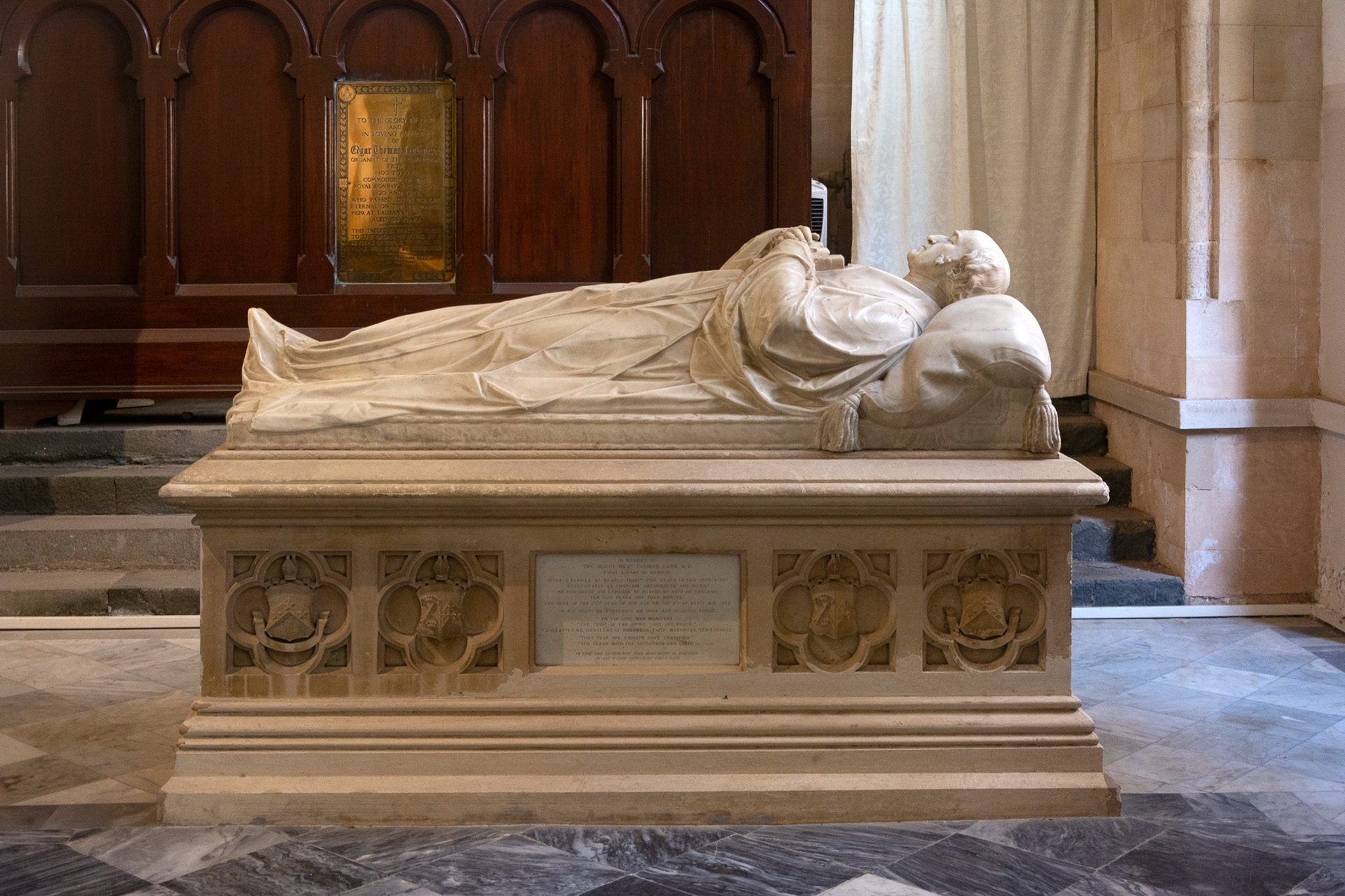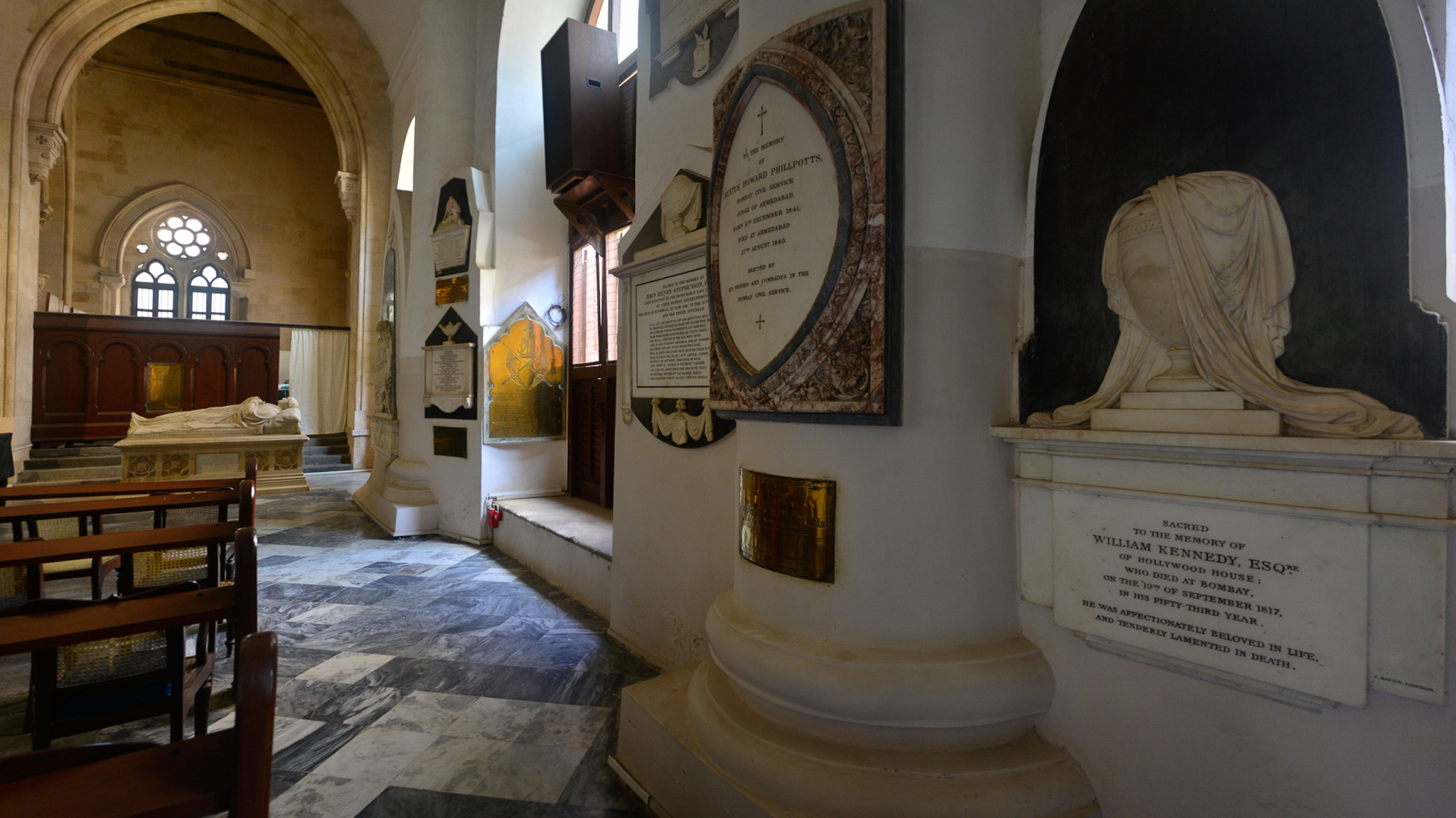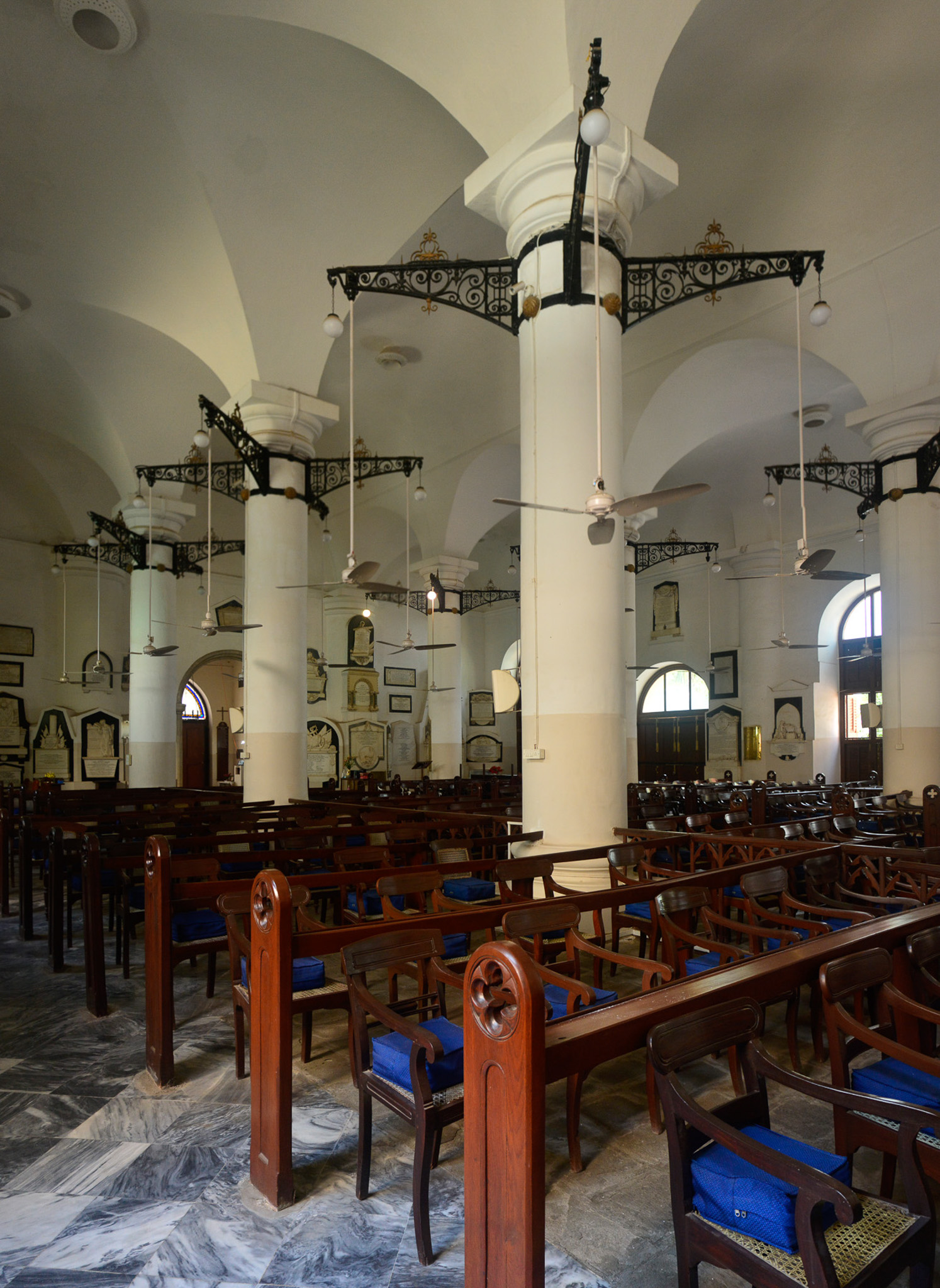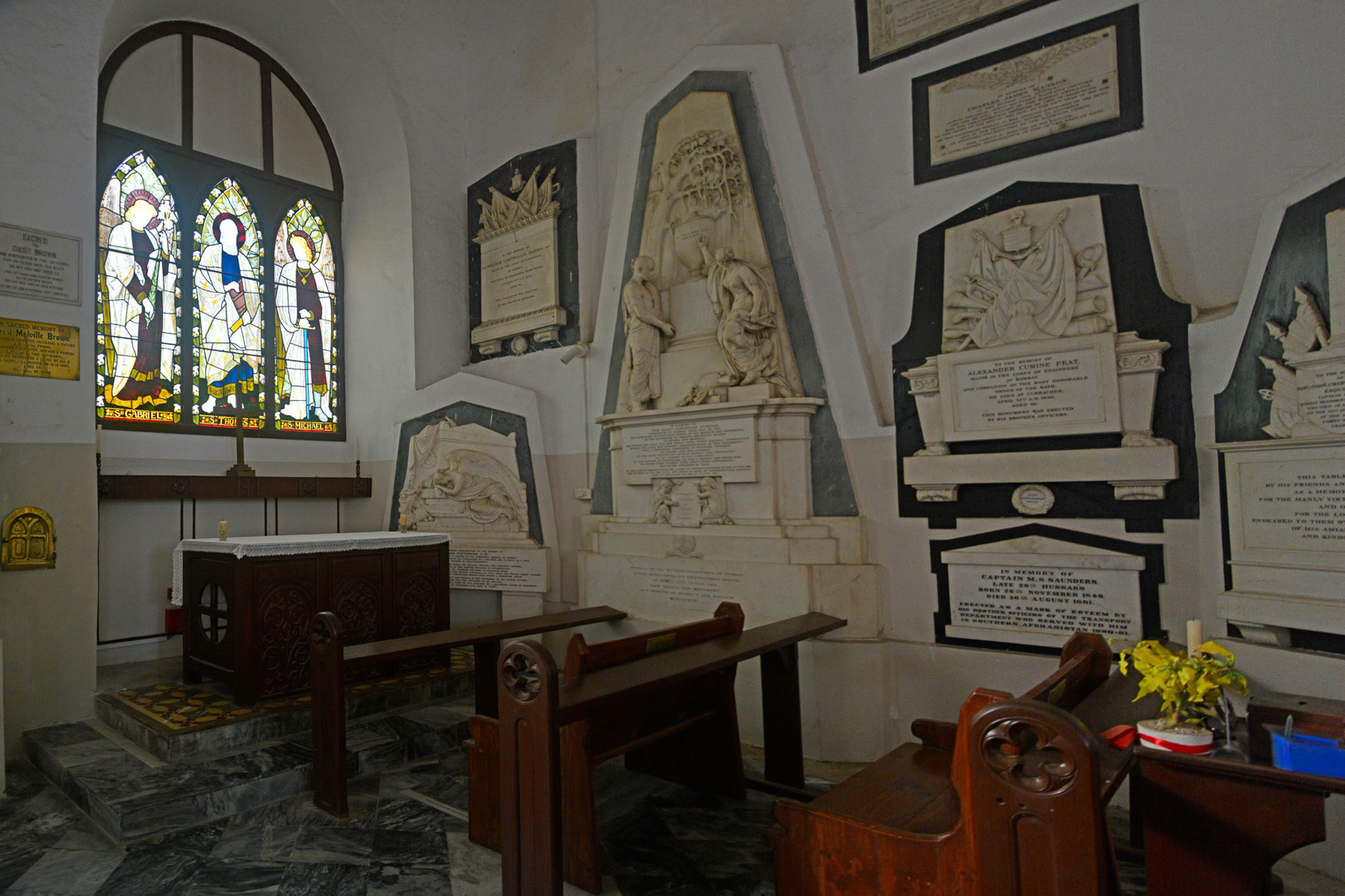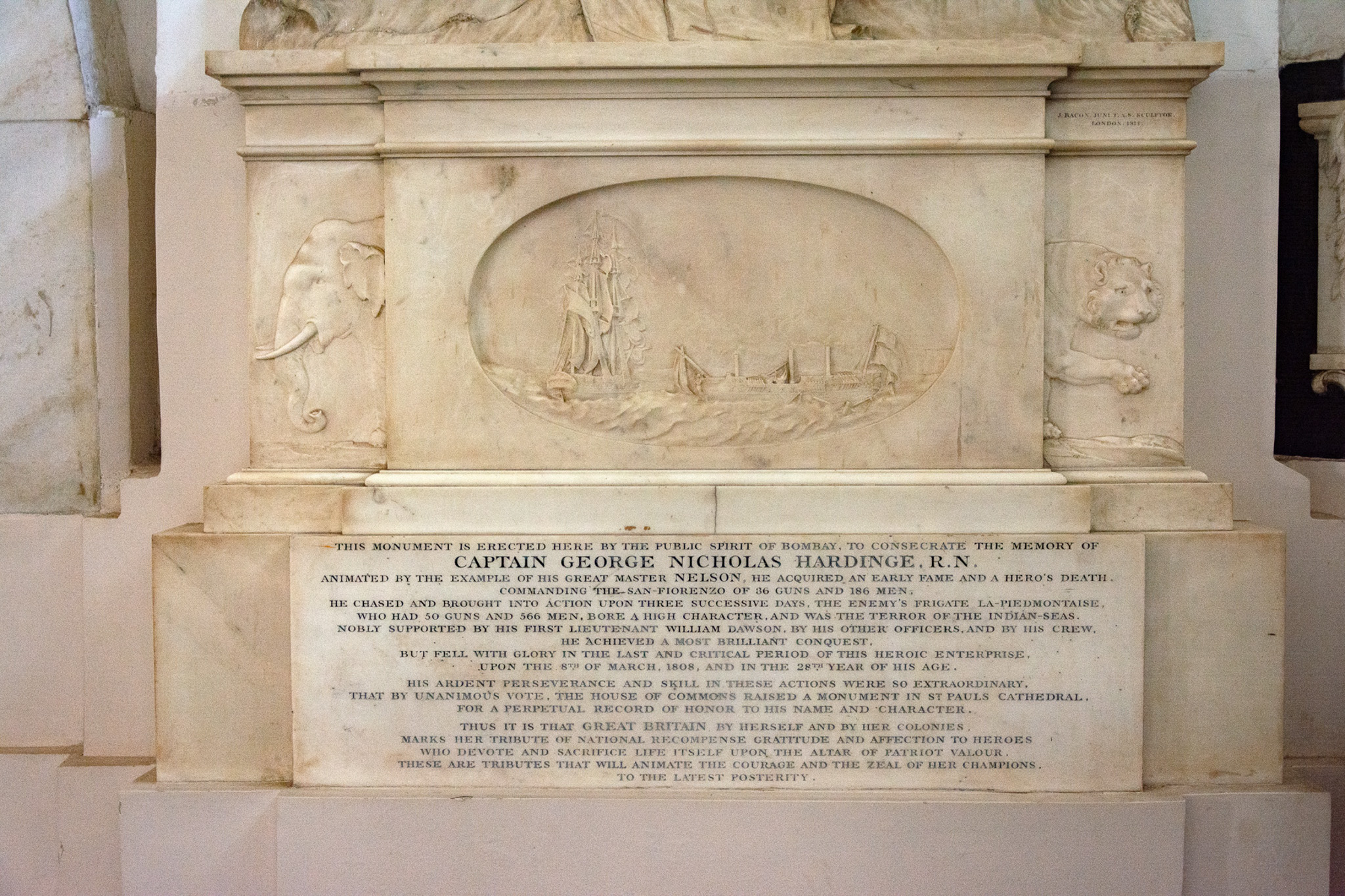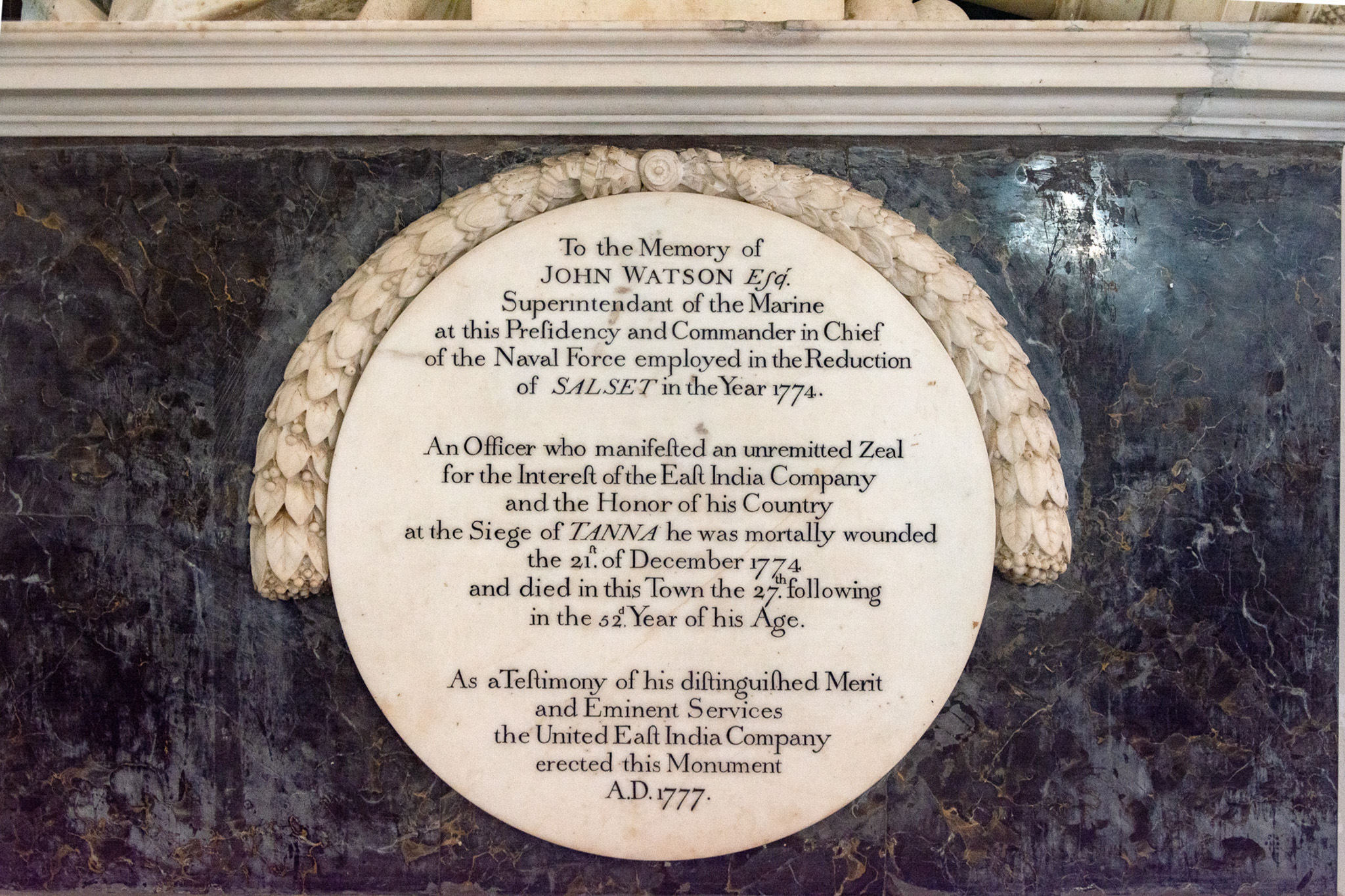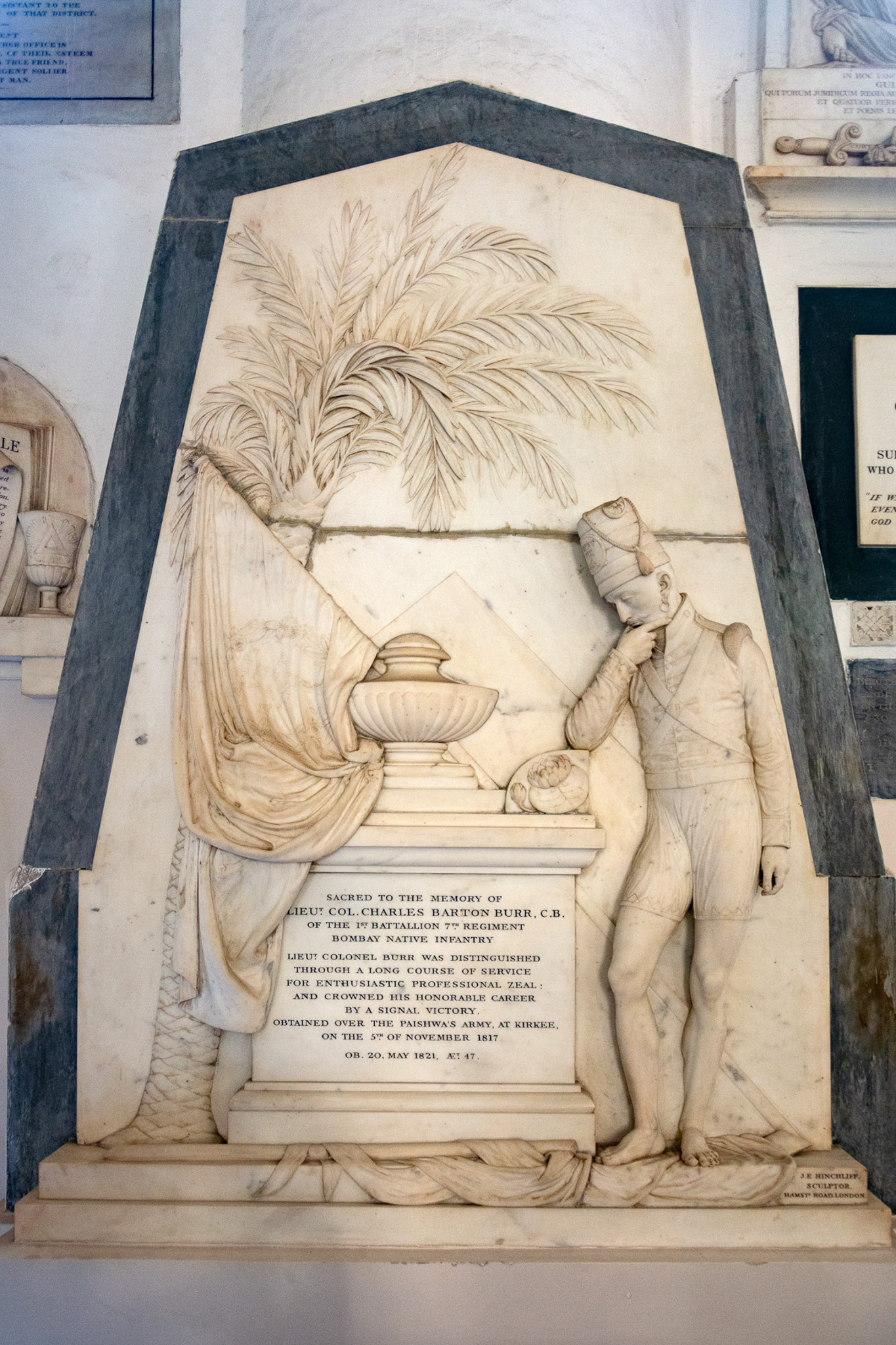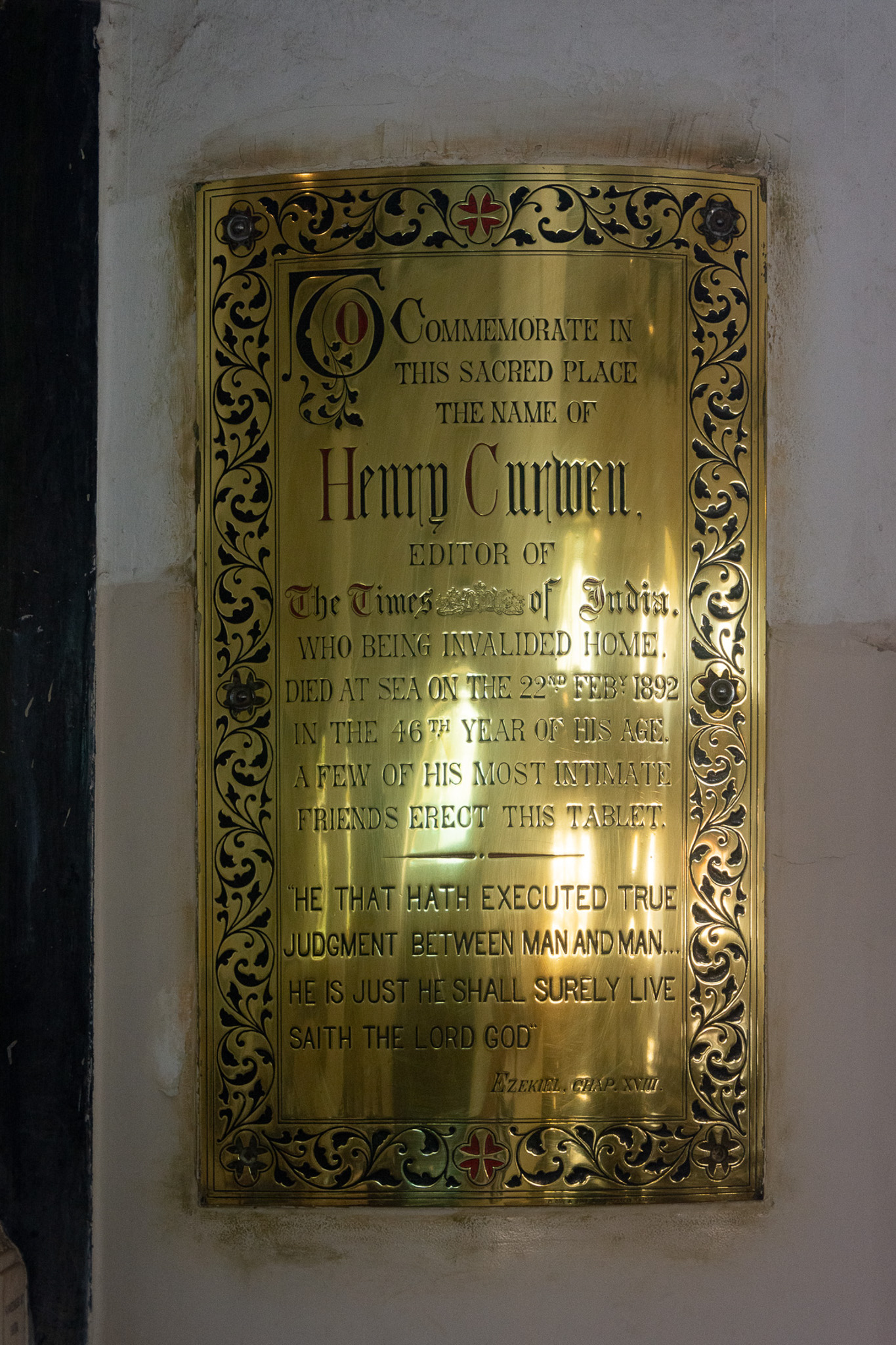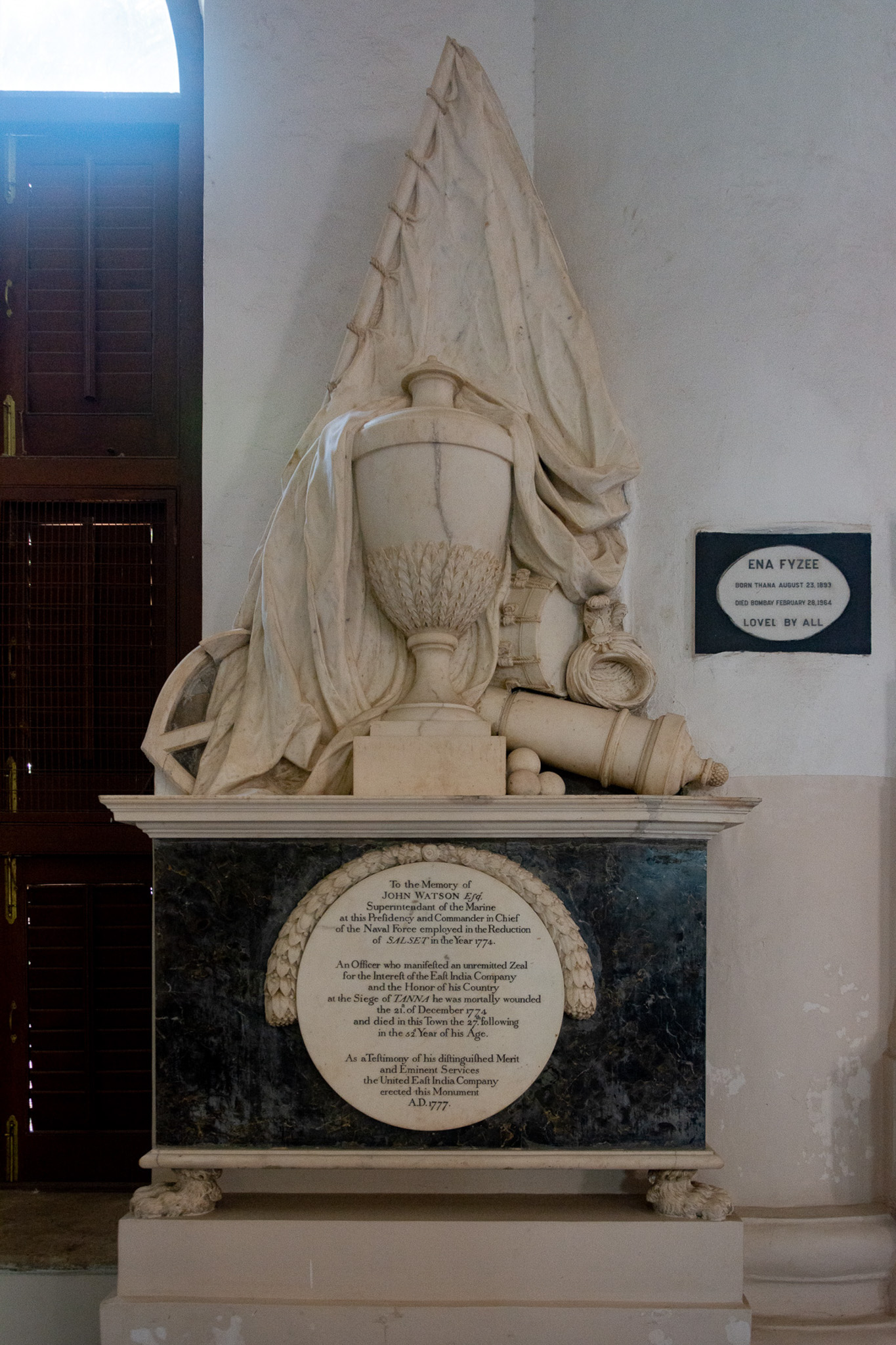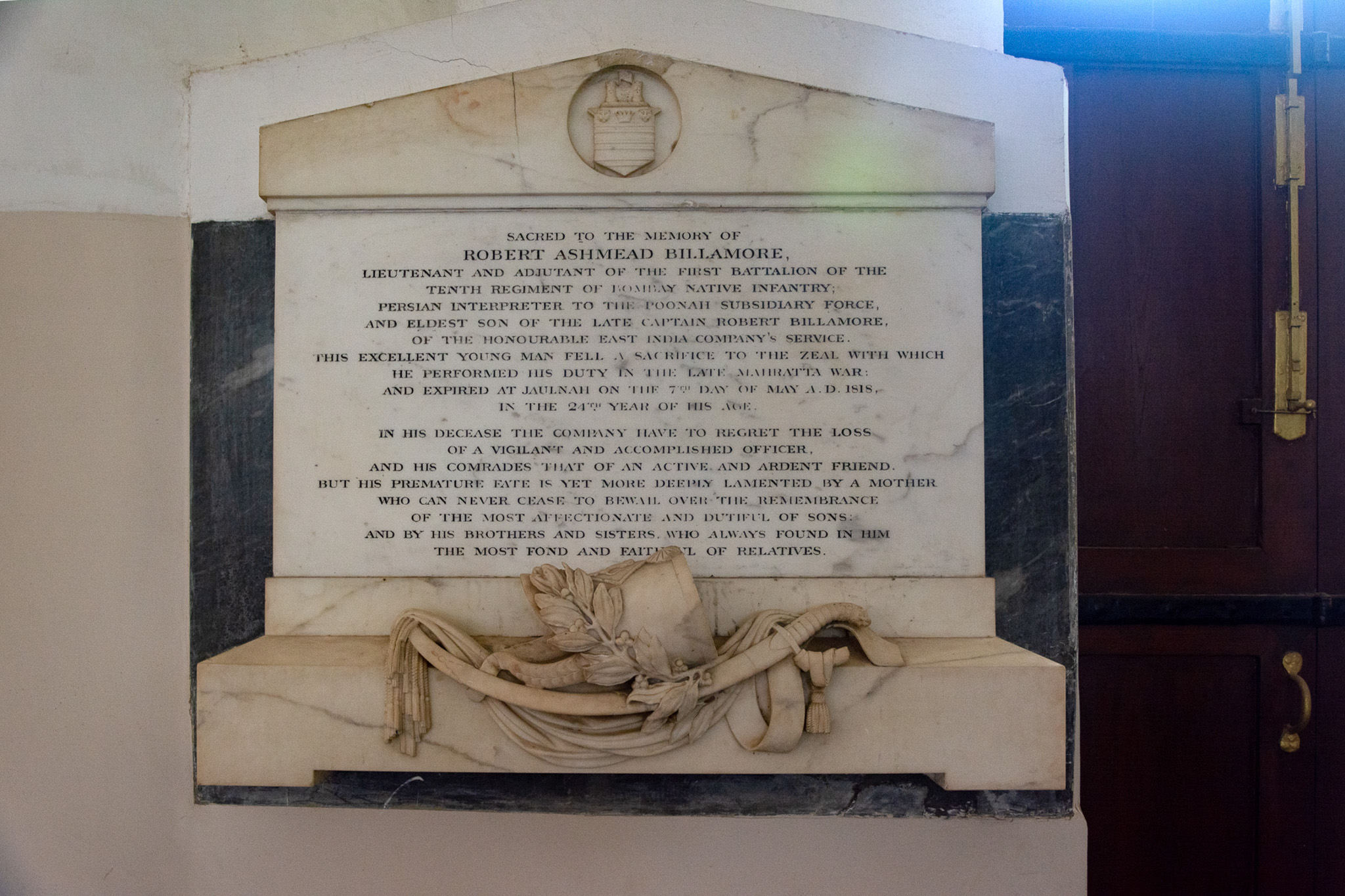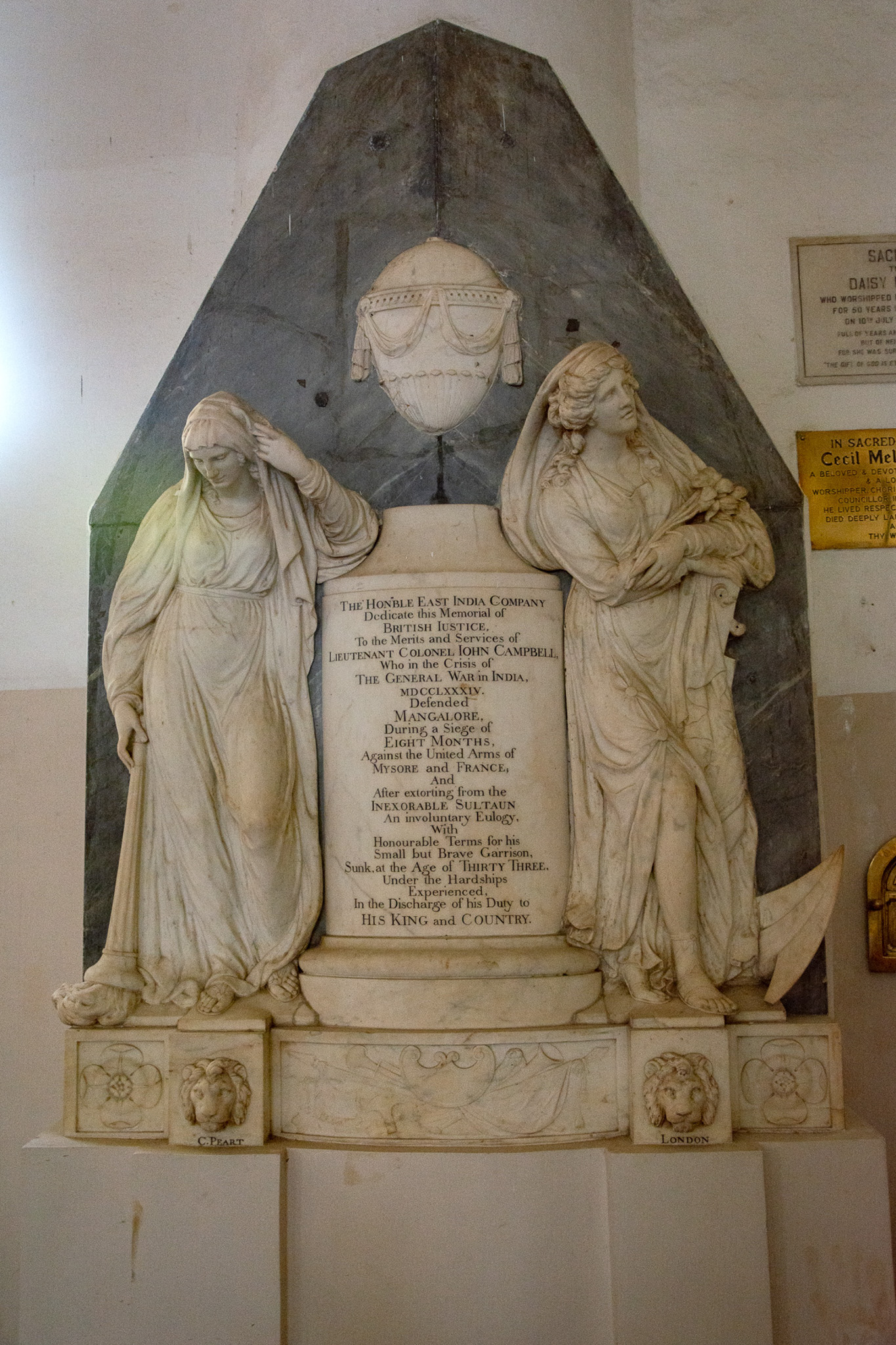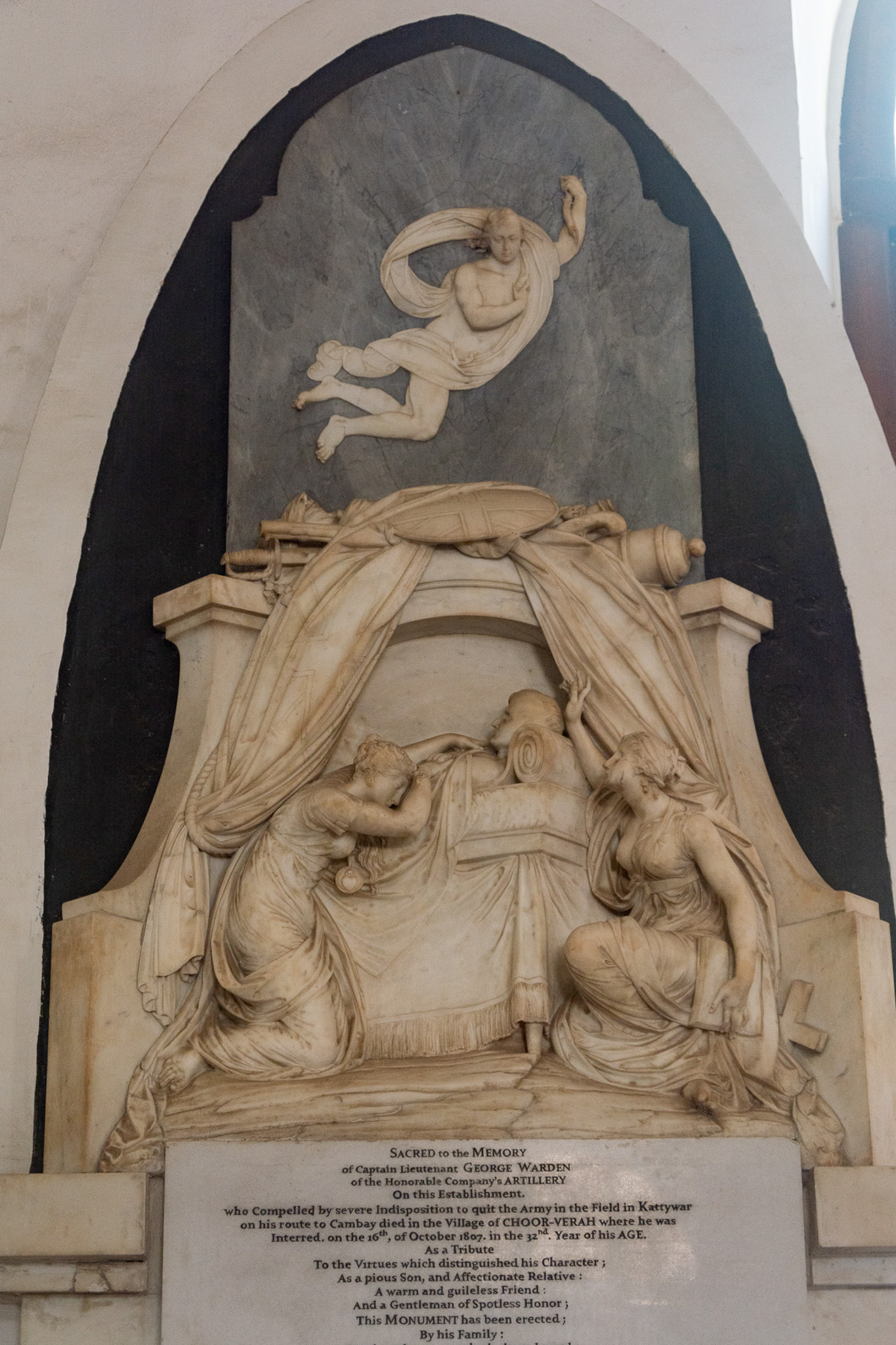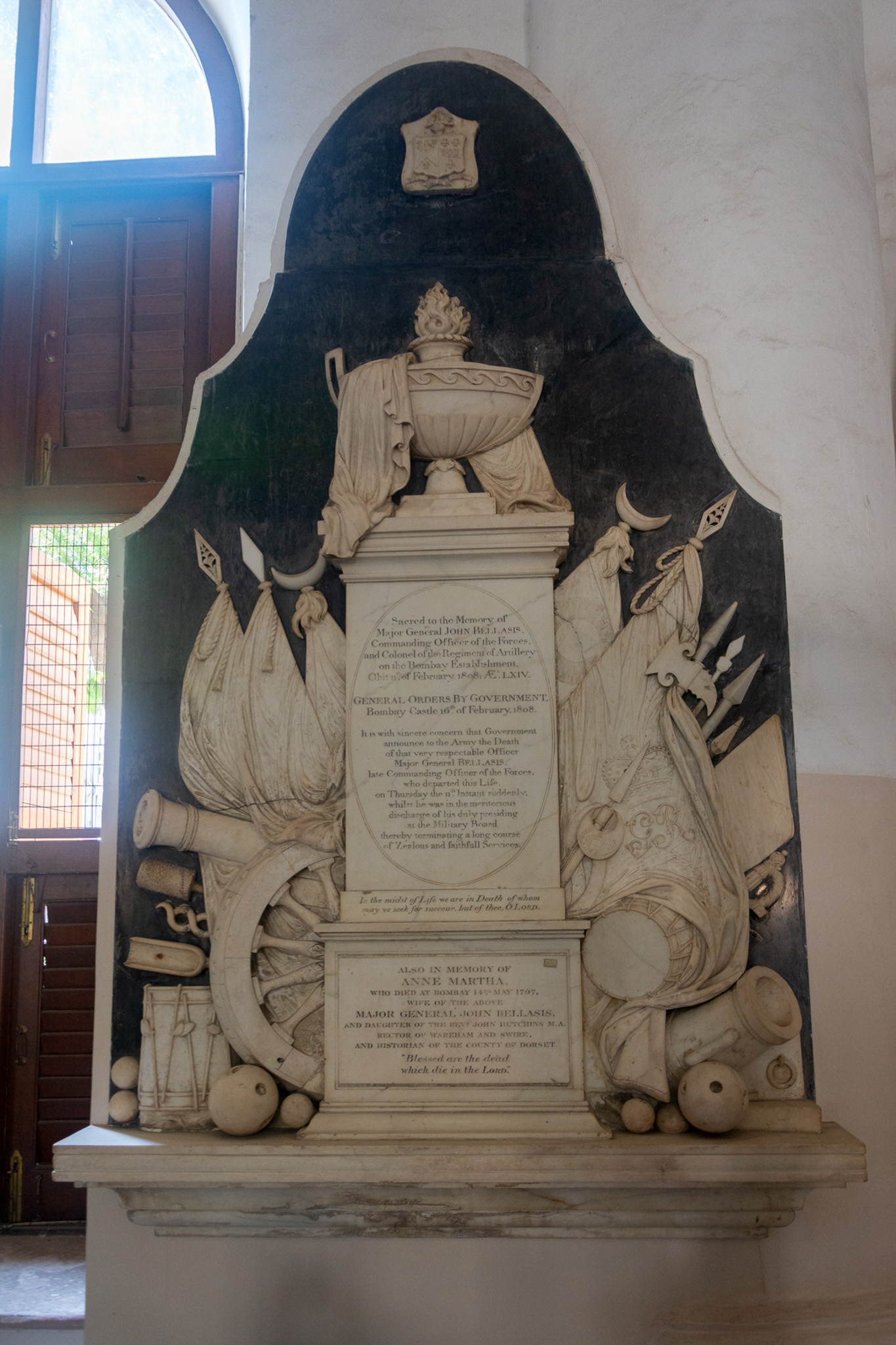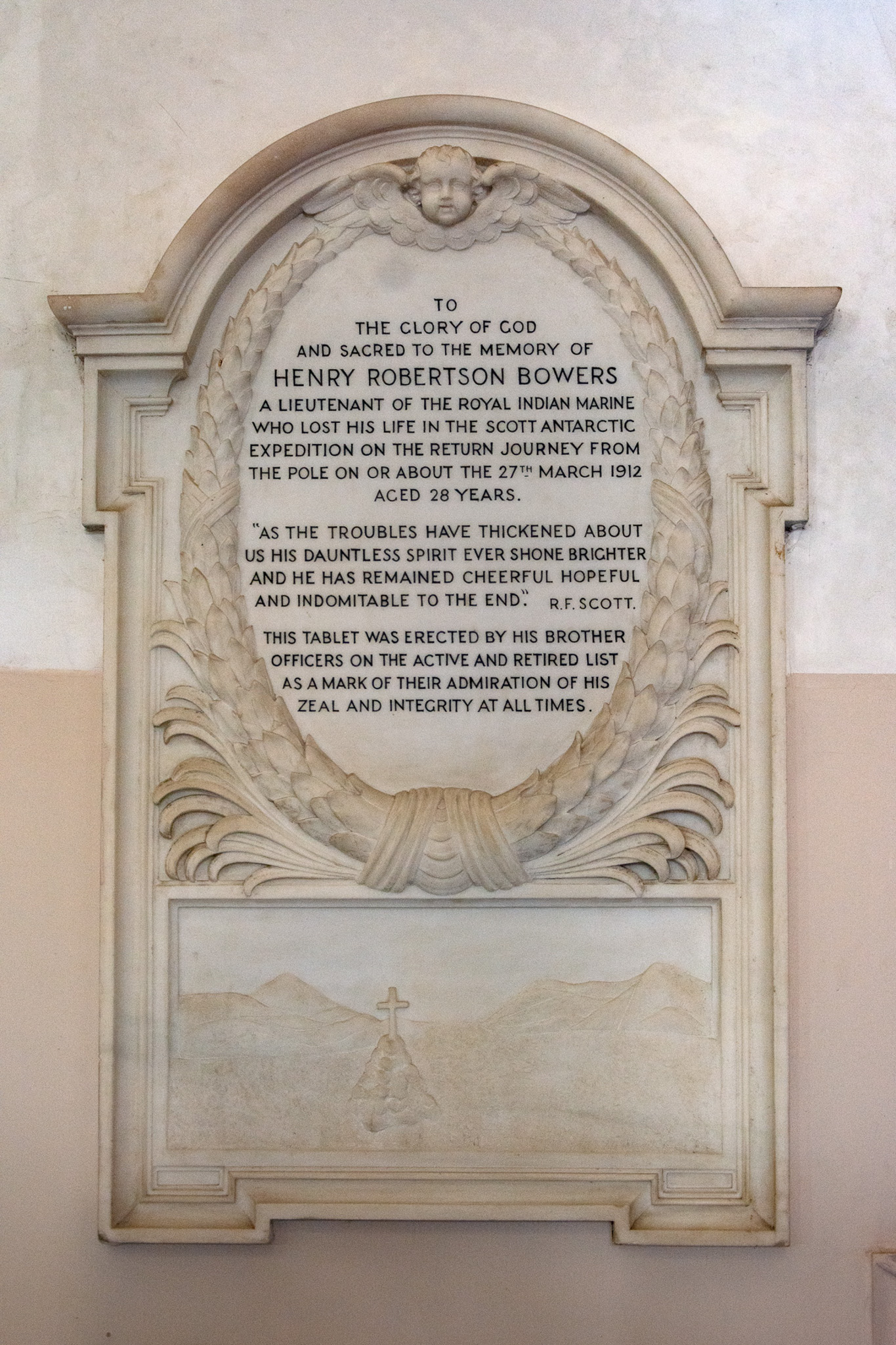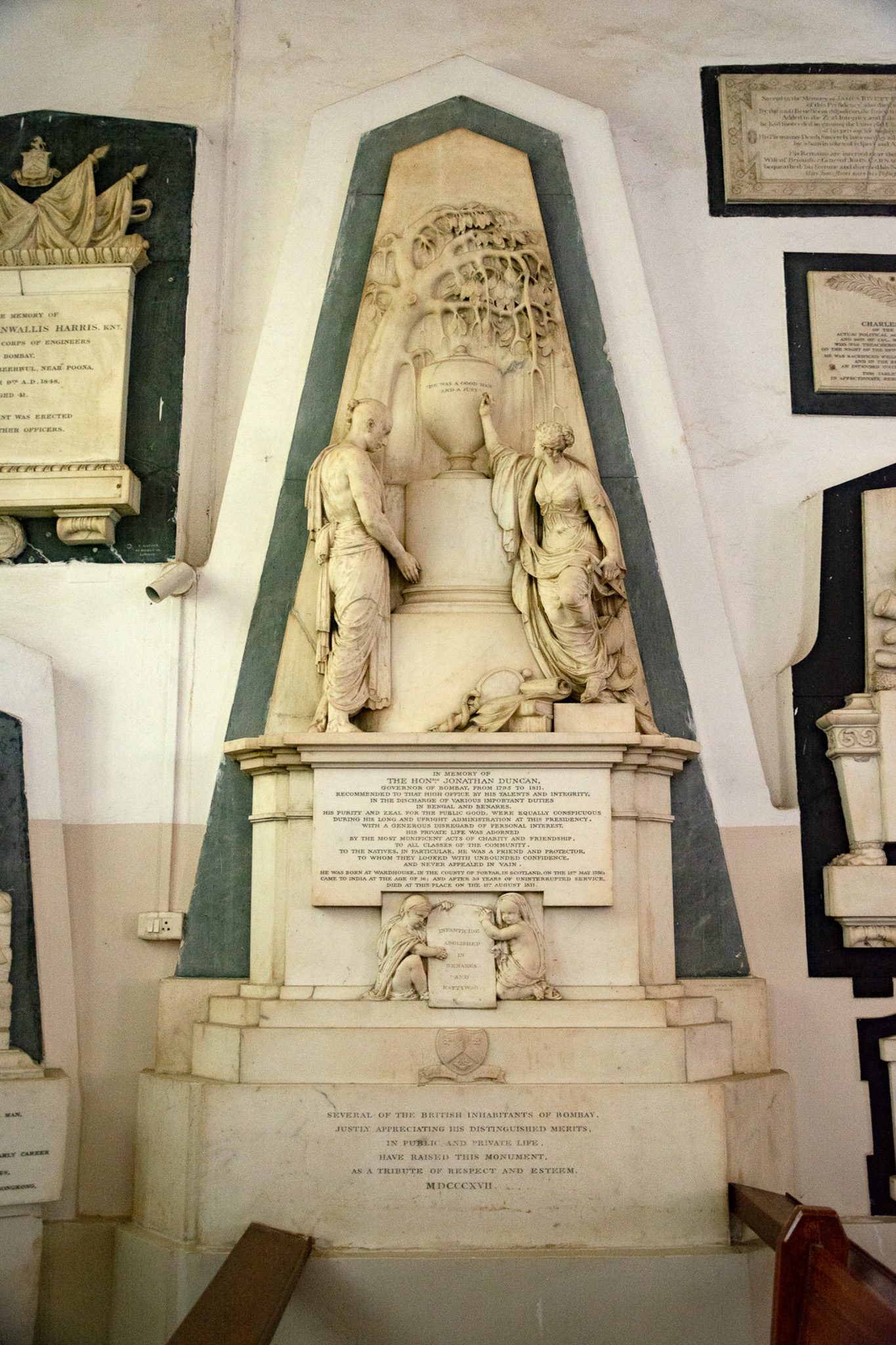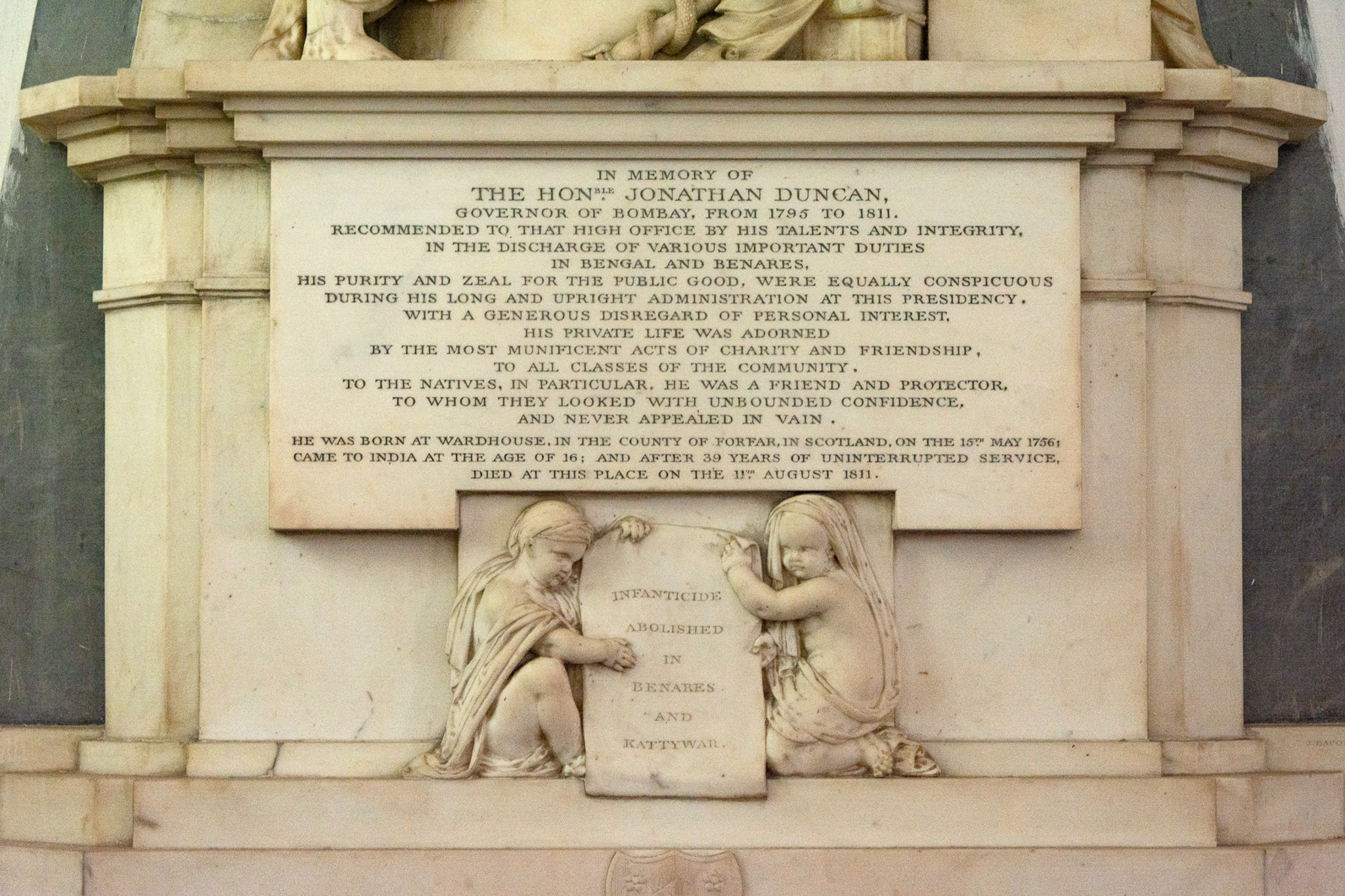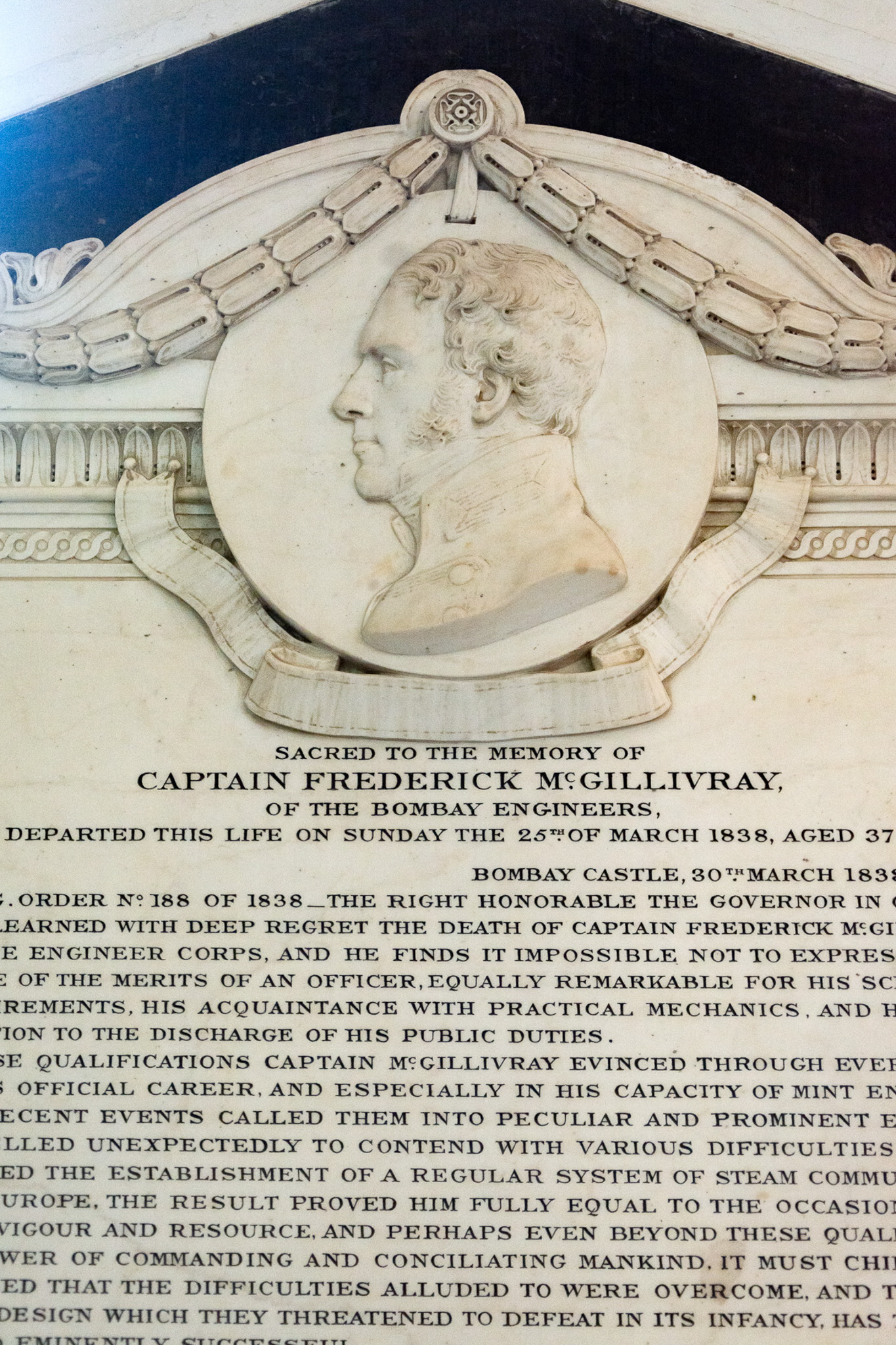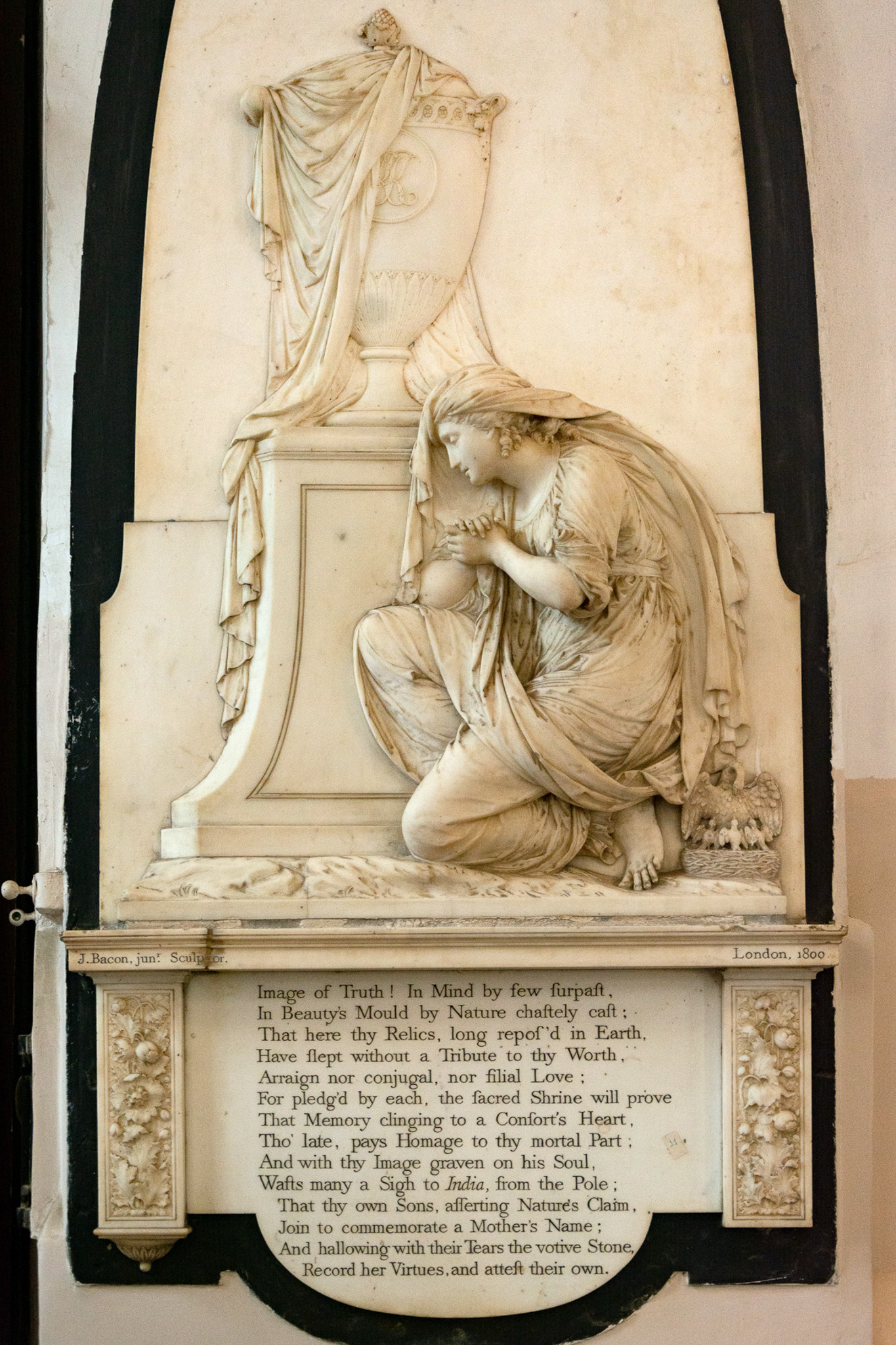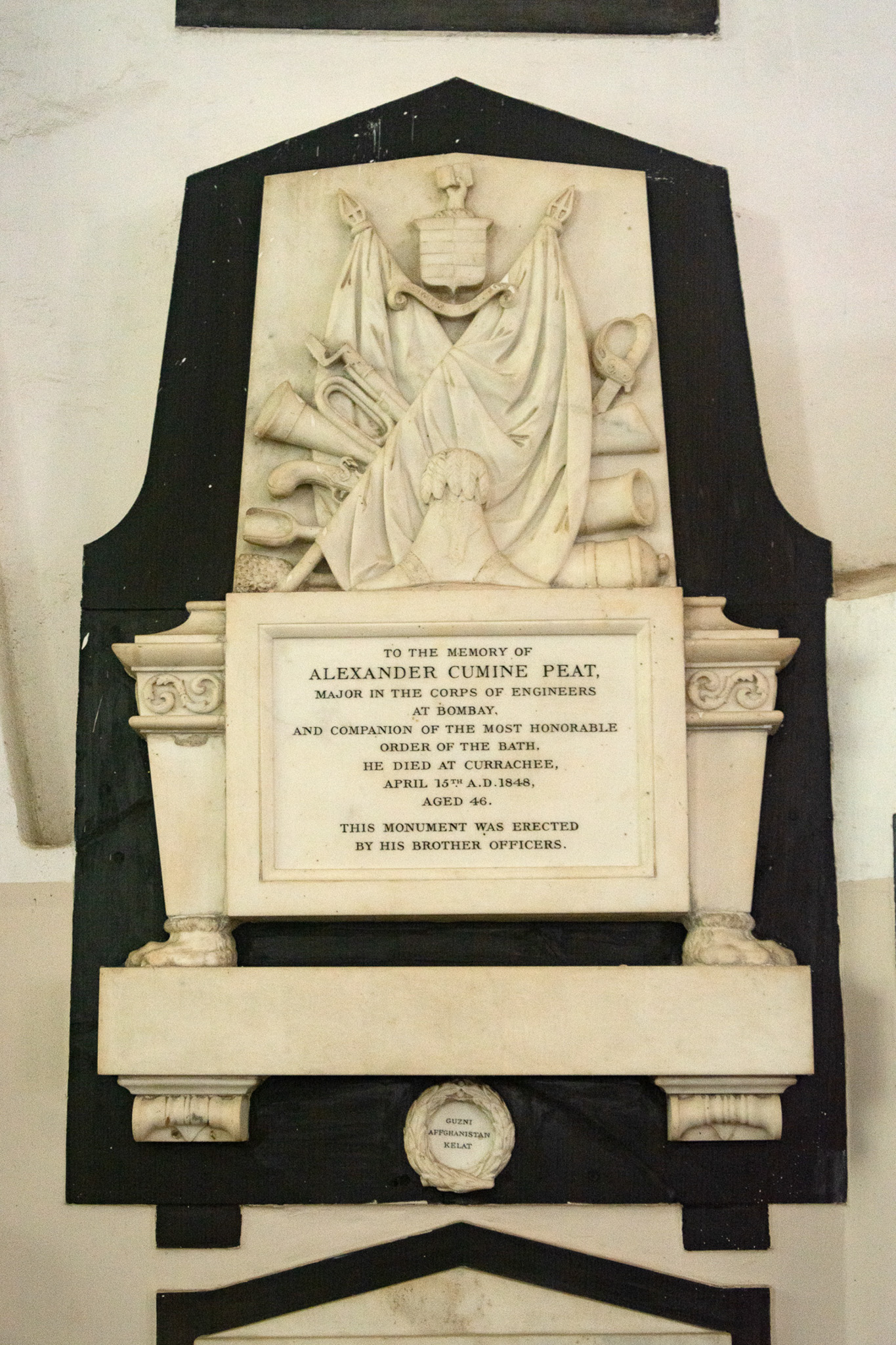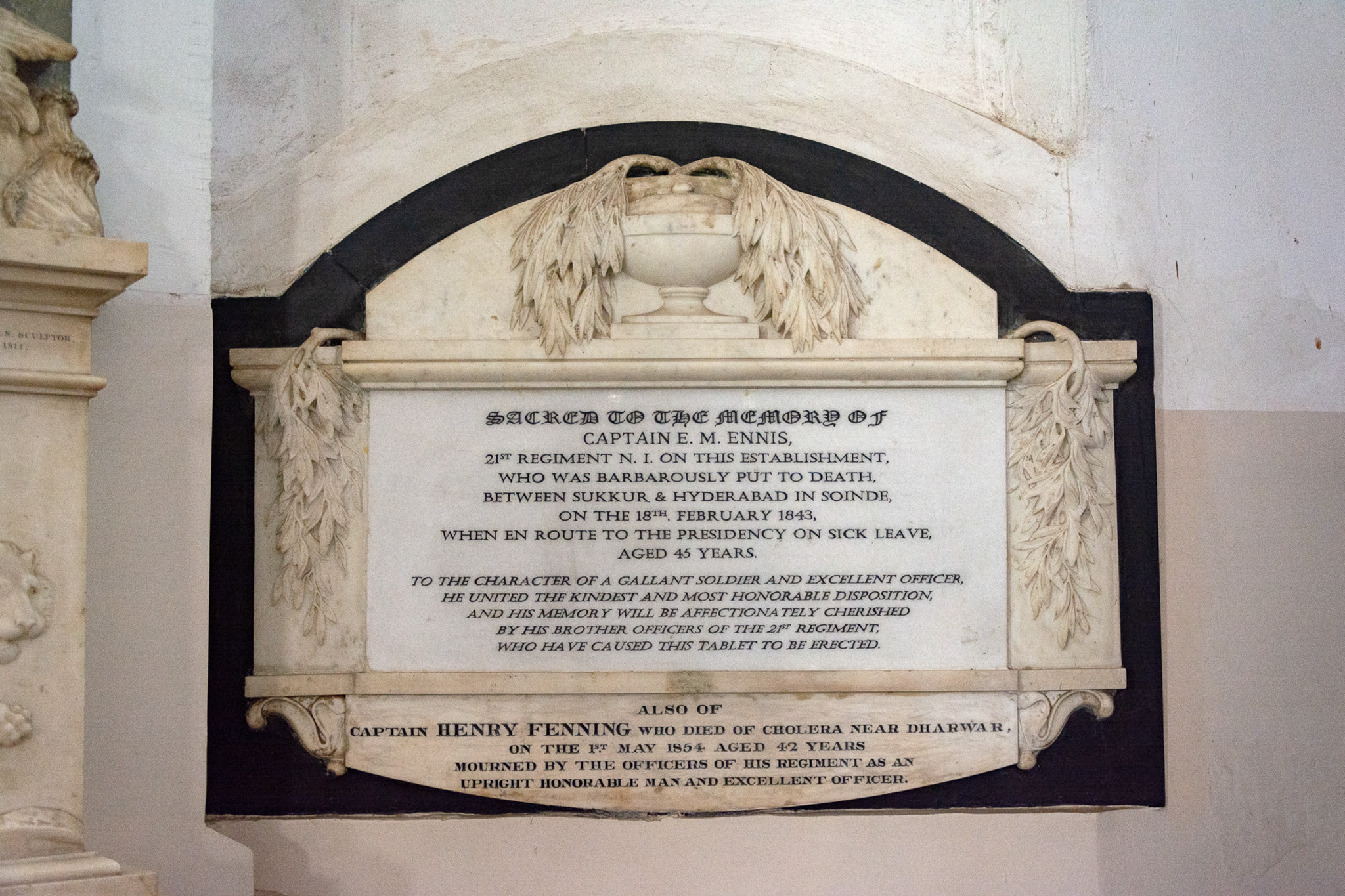St. Thomas Cathedral
St. Thomas Cathedral, Mumbai, is the 300-year-old cathedral church of the Diocese of Mumbai of the Church of North India. It is named in honour of Saint Thomas the Apostle, who is believed to have first brought Christianity to India. The cathedral is located in Horniman Circle, the historic centre of Mumbai. It is in close proximity to famous Mumbai landmarks such as Flora Fountain and Bombay House. It is one of the oldest churches in Mumbai.
The church's foundation stone was laid in 1676, but it was only finally consecrated for divine service in 1718. It is the first Anglican church in Mumbai (then called Bombay), within the walls of the fortified British settlement. The cathedral, one of India's oldest churches, is a landmark in South Mumbai and one of the oldest churches in India. In 1860, the church established the Cathedral and John Connon School to train choristers. The school uses it for its Founder's Day Service on November 14 every year, its Carol Service on the last day before the school's Christmas vacation, and for other special occasions.
The St. Thomas Cathedral inspired the name of the Churchgate railway station, as a road connected it to the cathedral through one of Mumbai's three fortified island gates. In 1862, the Bombay Fort demolished its walls, and the Flora Fountain replaced the gate leading to the church in 1864.
St. Thomas Cathedral, once the tallest structure in Fort, acted as a visual landmark. The spire underwent remodelling over the years to enhance its Gothic appearance. It houses a belfry and clock tower. The spire still houses the bells, installed in 1798, even though they are no longer operational. The clocks, however, are still operational.
St. Thomas Cathedral is Mumbai's first Anglican church and one of Bombay Fort's oldest structures. The church was built on an open space known as Bombay Green, which was later developed as Elphinstone Circle (Horniman Circle). The surrounding area is named Churchgate, after the city gate, which stood close to the church.
The Anglican community living within Bombay Fort dedicated St. Thomas Church to their spiritual needs. The foundation stone was laid by Governor Gerald Aungier, who pressed for the establishment of the church. Among the historic treasures kept at the church is a silver chalice presented by Gerald Aungier to the Anglican Christian community in 1675.
The memorial honors Richard Cobbe, the East India Company chaplain who "stirred up his countrymen to complete the church." Despite laying the foundation stone in 1676, the lack of funds, hostile enemy raids, and repeated plague outbreaks delayed construction. On Christmas Day, 1718, the church was consecrated for divine worship.
Charles Boone, the then Governor of Bombay, inaugurated St. Thomas church on Christmas Day, 1718. At that time, people referred to it as the Church of Bombay. Thomas Fanshawe Middleton, the first Anglican Bishop of Calcutta, consecrated the church on 7th June 1816 and dedicated it to St. Thomas the Apostle.
Reverend William Kew Fletcher, arch chaplain at the time, saw an opportunity to restore St. Thomas Church during the economic boom in the wake of the American Civil War (1861-1865). The Government of Bombay assigned the work to James Trubshawe, an architect, who prepared renovation plans in the traditional Gothic Revival architecture that was popular at the time.
James Trubshawe had ambitious plans for a complete makeover of St. Thomas Church, but he couldn't execute the plan in its entirety. Nevertheless, he recognised the emerging trend of Gothic Revival style and incorporated Gothic elements (like stained glass windows) to make the church appear visually consistent with Victorian Gothic buildings in Mumbai.
Latin inscription on Chancel steps
In recognition of Reverend William Kew Fletcher's contributions to the restoration of St. Thomas Church, his friends erected a memorial in the form of Latin inscriptions on the steps leading to the Chancel. The inscriptions include his name, his ecclesiastical rank (arch chaplain), and the Roman numerals of the year, MDCCCLXXI (1871), inscribed on the steps leading to the Chancel.
The St. Thomas Church is accessible from the west (seen on the right). Memorials cover the walls on both sides of the entrance lobby. The choir room occupies the antechamber in the centre. Above the choir room door hangs an old photograph of the Church Gate, which was demolished along with Bombay Fort's ramparts in the mid-1860s.
The chancel gate of St. Thomas Church was presented in 1865. Painted in black and gold, the wrought iron gate is intricately designed in a geometric pattern with decorative floral motifs. The detail is typical of Gothic tracery, known as patera, with flowers, flowing creepers, and leaves. The separate floral elements are riveted to the gate.
The lobby offers a view of St. Thomas Church's central hall. The chancel gates separate the hall from the lobby, also called the narthex. The purpose of the narthex was to allow those who were not eligible for admission into the general congregation to participate in the service from a distance. Minton tiles, made in Staffordshire, England, cover the floor.
The fanlight is stained glass with a golden cross. A foliage motif paired with a blue band runs around the border. A fanlight is a semicircular or semi-elliptical-shaped window with glazing bars or tracery sets radiating like an open fan, hence its name. This fanlight is placed above the door on the entrance (west) to St. Thomas Church.
The baptismal font is located on the left side of the entrance, adjacent to the west wall. The font was presented in 1861 and made from Caen stone. The font is supported by five squat pillars made of green Devonshire marble. The squat pillars rest upon basements also made from Caen stone, which in turn is supported by a plinth made from basalt stone.
In 1867, excavations at St. Georges Street, Canterbury, unearthed a Saxon-era brooch, dating from around 850 CE. A stone cross at Canterbury Cathedral replicated the design, cast in bronze with intricate decorations. Anglican cathedrals around the world display similar replicas, mounted on fragments of stone from Canterbury Cathedral. The Diocese of Bombay embeds the cross in the west wall of St. Thomas Cathedral, between the two plaques, as depicted in the figure above.
The Lady Chapel (seen here) is a traditional British term for a chapel dedicated to "Our Lady," Mother Mary. The chapel has some notable memorials, including Daniel Seton, Lieutenant-Governor of Surat Castle (top left), and Katherine Kirkpatrick (top right), mother to James Achilles Kirkpatrick, who served as Company Resident at Hyderabad (Deccan).
The St. Thomas Church altar features a kneeler. A kneeler is a cushion (a tuffet or hassock) used for resting the knees in a kneeling position during Christian prayer. The brass eagle lectern and grand piano can be seen in the background.
The church received a specially crafted brass eagle lectern in memory of Lieutenant General HF Hancock, who served in Mumbai as an Under Secretary to the government and as an inspector of railways. Subsequently, he received a posting in Kolkata as the Secretary of the Public Works Department. Hancock died in Calcutta in 1887 at the age of 53. The eagle acts as a symbol of St. John, one of the Twelve Apostles.
The Lectern (Bible stand) features the IHS Monogram, which represents the Holy Name of Jesus. IHS stands for the first three letters of 'Jesus' in the Greek language: Iota (I), Eta (H in capitalised form in Greek), and Sigma (S). In Latin, the inscription came to stand for Jesus, Saviour of Humankind, derived from Iesus (Jesus) Hominum (of humankind) Salvator (Saviour).
Seats used by King George V and Queen Mary
The two chairs used to sit during prayer services by King George and Queen Mary are marked with commemorative brass plaques with the date of their visit to St. Thomas Church. The royal couple had arrived in Mumbai onboard the steamship RMS Medina, and after spending a few days in Mumbai, they left by train to attend the Delhi Durbar.
Another famous visitor to the St. Thomas Cathedral was Mother Teresa (1910-1997), who attended prayer services at the church on 8th January 1983. A commemorative plaque is now placed on the pew (a long bench, seat, or enclosed box) used by her on the occasion, now placed at the front of the congregation.
Commemorative plaque, Mother Teresa
Commemorative plaques were placed on the pew, marking the visit by Mother Teresa on 8 January 1983. A second plaque was added to Mother Teresa's canonisation at the Vatican City on 4 September 2016 by Pope Francis. Henceforth, Mother Teresa was known as Saint Teresa of Calcutta.
St. Thomas Church originally featured a stone pulpit. Sculptors in Italy crafted the current pulpit from green Italian marble. AK Leslie and his wife, Grace Emily Leslie, donated it in loving memory of Emily's father, Sir George Cotton. The three figures on the pulpit are allegorical representations of faith, hope, and charity.
Since its founding in 1718, St. Thomas Church has maintained a choir. Following the elevation of the church to cathedral status in 1837, the Diocese of Mumbai founded a choir school to prepare singing boys for divine services. Most choristers, until the late 1970s, came from Cathedral & John Connon School.
Premchand Roychand was a benefactor to St. Thomas Cathedral. He was famously known as the "Bullion King of Mumbai." His generous contributions helped complete renovations, which lasted from 1862–1867 and resulted in an enlarged apse, chancel, and organ chamber (seen here). Public donations raised part of the Rs 1,63,000 cost, with the government funding the remainder.
An English priest led the large British congregation at St. Thomas Cathedral until the mid-1950s. With the steady departure of the British population and the emigration of Anglo-Indians from India, the congregation now comprised mostly Indian Christians. The Anglican Bishop of Bombay (Mumbai) is in charge of the church.
Stained glass artwork at the Apse
The apse of St. Thomas Church features glass panels. In the left panel, the 'doubting' St. Thomas inspects the wound of the 'Risen' Jesus. The central panel depicts Jesus on the cross, surrounded by angels. Below the crucifixion, Mother Mary holds the infant Jesus on her lap. The right panel depicts Jesus' ascension to heaven, witnessed by the Apostles.
St. Thomas with Archangels Michael and Gabriel
The southwest corner of St. Thomas Church has triple-stained glass windows showing the figures of St. Thomas (in the centre) flanked by the Archangels St. Michael (right) and St. Gabriel (left). Their respective names appear at the bottom of each panel.
Stained glass work, Archangel Gabriel
The stained glass panel features a winged figure of Archangel Gabriel carrying lilies. The Hebrew Bible, the New Testament, and the Quran all mention Gabriel. Many Christian traditions—including Catholicism, Eastern Orthodoxy, Lutheranism, and Anglicanism—regulate Gabriel as a saint.
Stained glass work, Archangel Michael
The panel of stained glass features a winged representation of Archangel Michael, adorned with a cross, a tiara, and a pendant. Michael is an archangel in Judaism, Christianity, Islam, and the Baha'i faith. The story in the Book of Revelation depicts Michael as a warrior, wielding a sword and triumphing over a dragon.
Memorial, Reverend Thomas Carr
A memorial to Reverend Thomas Carr, First Bishop of Bombay, was erected by his wife, Catherine Emily Carr, upon his death (at Somerset, 1859). Thomas Carr began his service with the East India Company in 1817 as a Chaplain, and in 1833, he received an appointment as the Archdeacon of Bombay. On November 19, 1837, the East India Company consecrated him as Bishop of Bombay.
St. Thomas Church was built long before electricity was available, and thus, it relied on natural light for illumination. The north and the south walls are divided by rows of tall windows, which allow sunlight and air circulation when the church is used for service on Sundays. Over the years, some of the windows got covered in stained glass.
Built long before electricity became available, St. Thomas Church relied on natural light for illumination. Tall windows divide the north and south walls, allowing sunlight and air circulation during Sunday service. Stained glass covered some of the windows over the years.
The interiors have hundreds of memorial plaques erected by friends and family members in memory of their loved ones. The East India Company also erected memorials in honour of EIC officers and administrators who died of natural causes, perished at sea, or lost their lives in the line of duty during various military campaigns in the Bombay Presidency.
The memorials contain an epitaph eulogizing the qualities of the deceased person, as well as their position or rank in society (or in the military), age, place, circumstances, and date of death. Some memorials have funerary art designed in the Neoclassical style, showing portraiture, funerary urns, military symbols, or allegorical figures in mourning.
Memorial dedicated to John Watson
St. Thomas Church has many memorials dedicated to officers who served in the East India Company. John Watson, the commander-in-chief of the naval force involved in the 'Reduction of Salsette', is the subject of this 1777 memorial. On 21st December 1774, during the Siege of Tanna (Thane), he suffered mortal wounds and died six days later at Thane.
Memorial dedicated to Daniel Seton
Daniel Seton, Lieutenant-Governor of Surat Castle, died on April 17, 1803. A memorial has been dedicated to him. In 1612, the East India Company (EIC) had set up their first factory at Surat, which was the seat of the company’s trade. However, when the EIC took possession of Mumbai and made it their focus of commerce and governance, Surat declined in importance.
Memorial dedicated to Lieutenant Colonel Charles Burton Burr
The memorial is dedicated to Lieutenant Colonel Charles Burton Burr, who passed away in 1821. He played a significant role in the defeat of the Peshwa Army during the Battle of Kirkee on 5 November 1817, during the Third Anglo-Maratha War (1817-1819). The barefoot soldier on the right wears the uniform of the 1st Battalion, 7th Regiment of the Bombay Native Infantry, which Charles Burton Burr commanded.
Memorial dedicated to Henry Curwen
Memorial plaque erected in memory of Henry Curwen (1845–1892), who died on 22nd Feb 1892, on board the P&O ship SS Ravenna, three days out of Mumbai. The vessel didn't return to port, and the body was buried at sea. Henry Curwen was born at Workington Hall in Cumbria and arrived in India in 1876 to work as a journalist. In 1880, he became the editor of the Times of India.
Memorial dedicated to John Watson
The memorial is dedicated to John Watson, who served as the Superintendent of the Marines and Commander-in-Chief of the naval force that attacked Salsette in 1774. He took part in the Siege of Thane, sustained mortal wounds on 21st December 1774, and succumbed to his wounds six days later, on 27th December, at the age of 52. The East India Company erected the monument in his honour in 1777.
Memorial dedicated to the frigate Cleopatra
The memorial is dedicated to the commander, officer, and sailors of the East India Company's steam frigate Cleopatra, which sank in a hurricane off the Malabar coast on 15th April 1847. The ship was constructed at Northfleet and arrived in Mumbai on April 19, 1840. It served as a transport and mail steamer between Mumbai and Karachi, Aden, and Suez. Officers and seamen of the Indian Navy erected the memorial.
Memorial dedicated to Robert Ashmead Billamore
A memorial to Robert Ashmead Billamore, Lieutenant and Adjutant of the First Battalion of the 10th Regiment of the Bombay Native Infantry, has been dedicated. He died at Jalna on 7 May 1818, during the Third Anglo-Maratha War, which ended Peshwa rule in the Deccan. His late father, Robert Billamore, had served as a captain in the East India Company Marine Corps.
Memorial dedicated to Lieutenant Colonel John Campbell
The East India Company erected a memorial in honor of Lieutenant Colonel John Campbell, who bravely defended Mangalore for eight months during the siege by the Kingdom of Mysore (supported by the French) during the Second Anglo-Mysore War (1780-1784). Campbell survived the siege but died from hardship at the age of 33. British sculptor Charles Peart (1759–1798) engraved his memorial on the pedestal (below the lion faces) in London.
Memorial dedicated to George Warden
English sculptor John Bacon Jr. commissioned this memorial to honor artillery captain George Warden, who served in the Bombay army and passed away at the age of 32 on 16th October 1807 in the village of Choor-Verah. The mourning scene shows Affection (left) grieving over the captain's body on a bed, while Faith (right) holds a book and gestures to George Warden's departing soul (top).
Memorial dedicated to Major General John Bellasis
The memorial honors Major General John Bellasis, who served as the commander of the East India Company army in Mumbai and passed away on February 11, 1808, at the age of 64. The memorial also honors his wife, Anne Martha, who passed away in Mumbai on 14 May 1797. The couple got married at St. Thomas Church on 3rd June 1776. Bellasis Road in Mumbai is named after John Bellasis, who built it in 1793 as part of a famine relief effort.
Memorial dedicated to Henry Robertson Bowers
Memorial dedicated to Henry Robertson Bowers, Lieutenant of the Royal Indian Marine, who lost his life on the ill-fated British Antarctic Expedition of 1910–1913, led by Captain Robert Falcon Scott (1868–1922). Roald Amundsen's polar party beat the team in the race to reach the geographic South Pole. Bowers, Scott, and other members of the party ran out of food and perished on the return journey sometime around 27 March 1912.
Memorial dedicated to Jonathan Duncan
Born in Scotland, Jonathan Duncan came to India at the age of 16. He began his career in India in 1772, and in 1784, he was one of the charter members of the Asiatic Society founded in Calcutta by William Jones. In 1791, he started the Sanskrit College in Benaras to promote the study of Hindu laws and philosophy. His memorial, featuring a dhoti-clad, bare-chested Brahmin scholar, reflects his lifelong interest in cultivating Brahminical knowledge.
Memorial dedicated to Jonathan Duncan
Lord Cornwallis appointed Jonathan Duncan superintendent and resident at Varanasi (also known as Benares) in 1788, where he abolished the practice of infanticide, primarily affecting female newborns. Later, he served as Governor of Bombay from 1795 until his death in 1811. As Governor, he banned infanticide in Kathiawar (known as Kattywar).
Memorial dedicated to Captain Frederick McGillivray
The memorial honors Captain Frederick McGillivray of the Bombay Engineers, who passed away on 25th March 1838 at the age of 37. At Bombay Castle, he served as an engineer at the Mint and was an early proponent for the establishment of a regular system of steam communication with Europe.
Memorial dedicated to Katherine Kirkpatrick
The memorial honors Katherine Kirkpatrick, the wife of Major General James Kirkpatrick, who served as the Commander of Horse in the Madras Army. She was mother to James Achilles Kirkpatrick, who later served as a company resident at Hyderabad (Deccan) from 1798 until 1805. Another son, William Kirkpatrick, also worked for the company in Hyderabad. Katherine was born at Fort St. George (Chennai) on 22nd September 1744 and died there on 27th January 1766, at age 22.
Memorial dedicated to Alexander Cumine Peat
Alexander Cumine Peat, a Major in the Corps of Engineers at Bombay, passed away at Currachee (Karachi) on 15th April 1848, at the age of 46. The memorials serve as markers of the expanding territories of the Bombay Presidency, which by the late 19th century came to include parts of Sindh Province (1847–1935) and Aden, now part of Yemen (1839–1932).
Memorial dedicated to Sir Frederick Lewis Maitland
The memorial is dedicated to Captain EM Ennis, who was brutally killed between Sukkur and Hyderabad in Soinde on 18th February 1843, while on sick leave en route to the Presidency, at the age of 45. In 1854, they added a second memorial to honor Captain Henry Fenning, who succumbed to cholera at Dharwad. The East India Company annexed Soinde, modern-day Sindh, in 1843, and a few years later, it became part of the Bombay Presidency.
Memorial dedicated to James Fawcett Esq.
A memorial dedicated to James Fawcett Esq. and his two infant children was erected by his widow upon his death on September 17, 1831, in London, aged 31 years. His mother, Helen Hitchens, was the daughter of Major General John Bellasis, an East India Company officer and commander of the forces at Mumbai. James Fawcett had, for a period, lived with his family in Mumbai, where he was a partner in the firm Messrs. Remington & Co.
